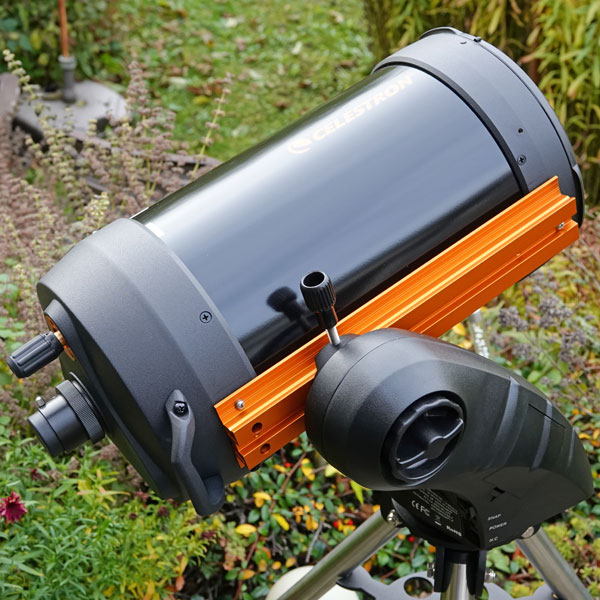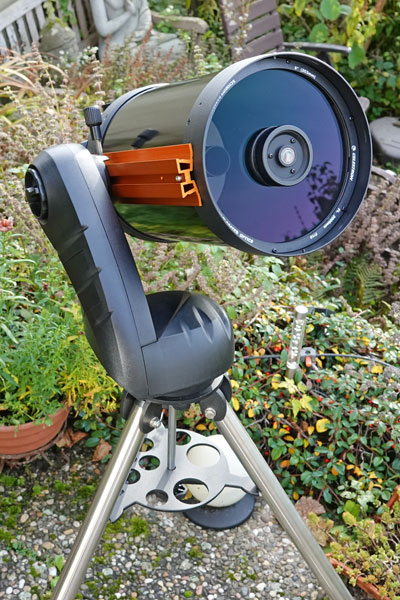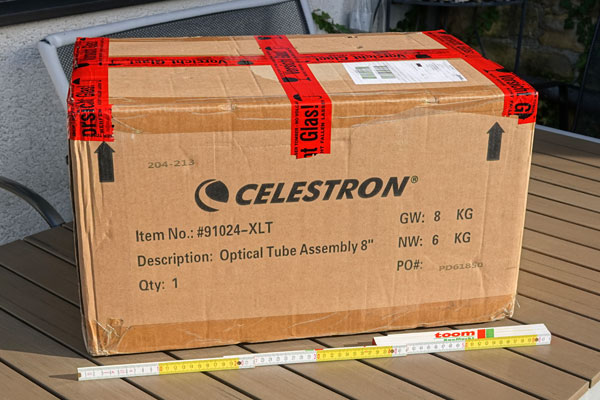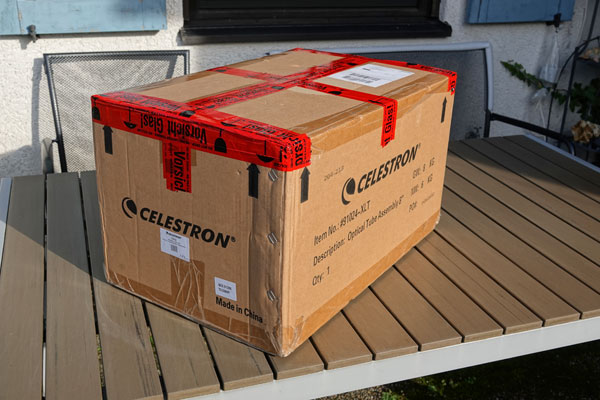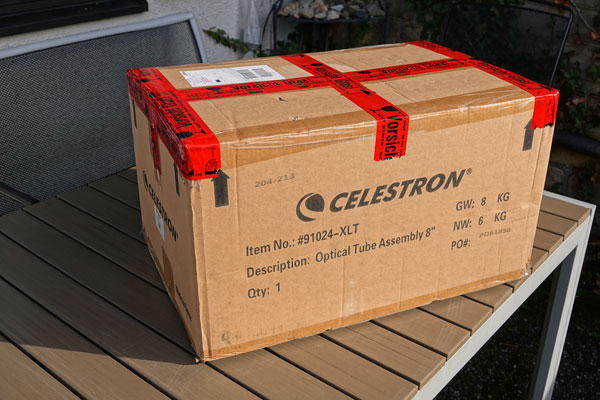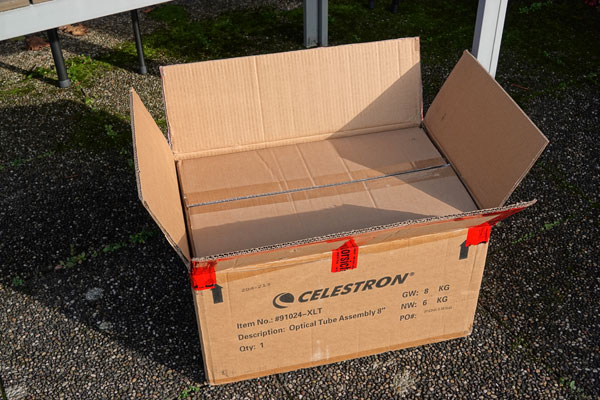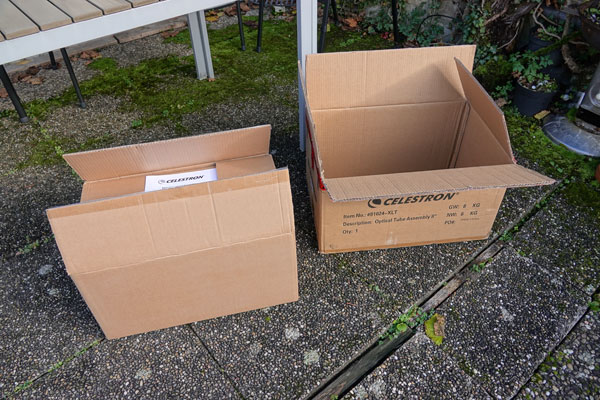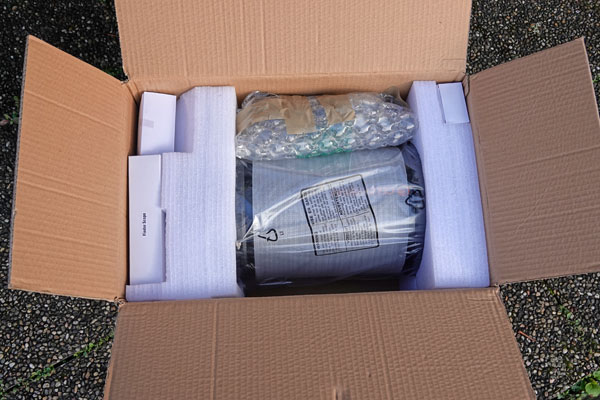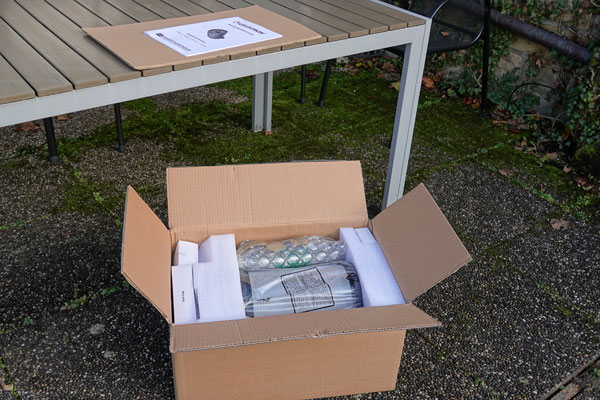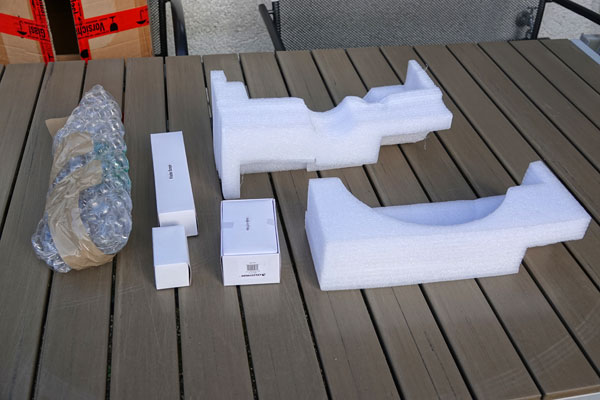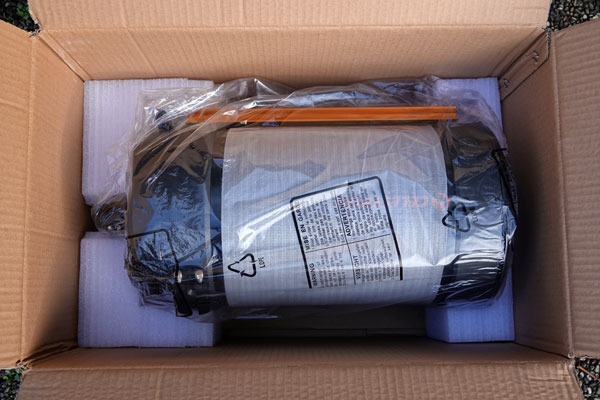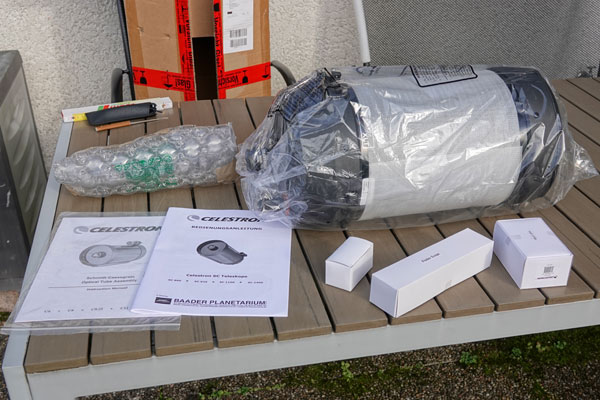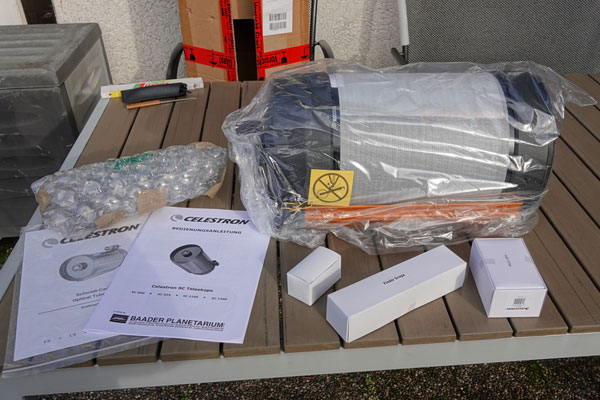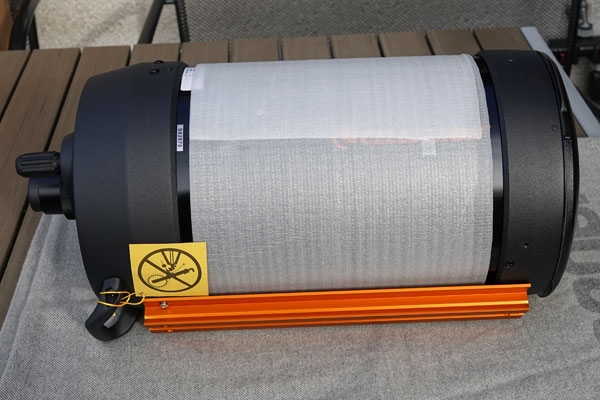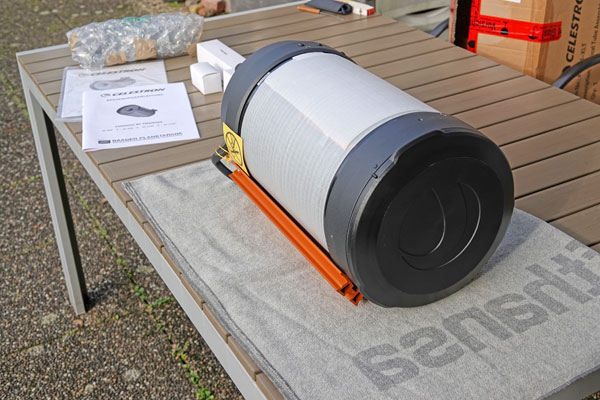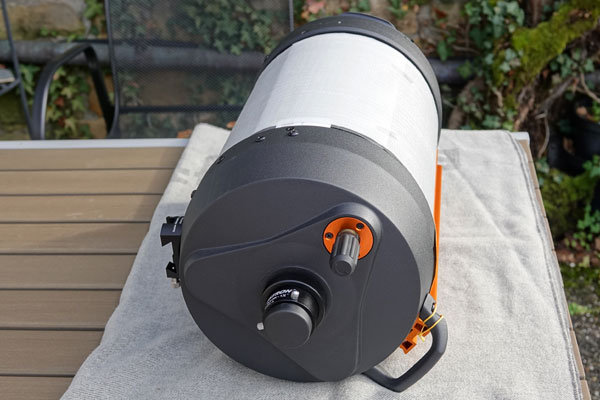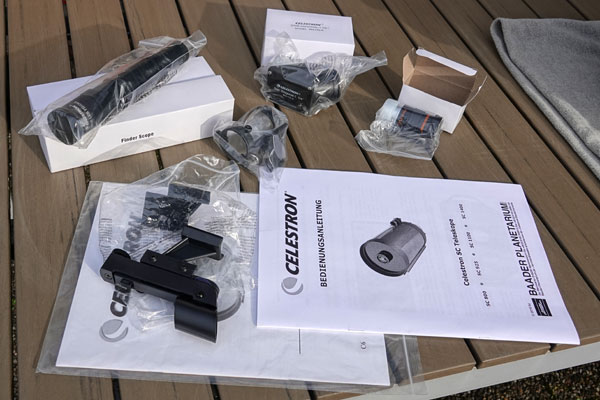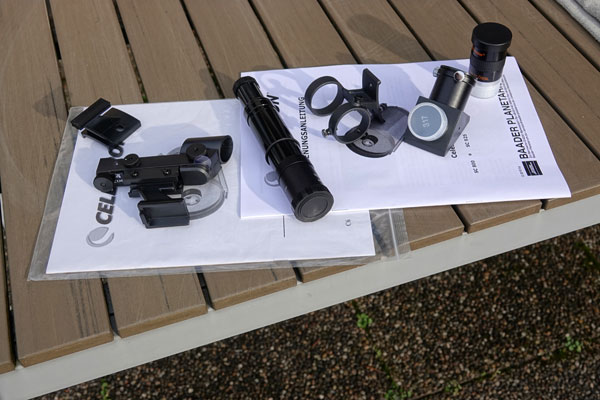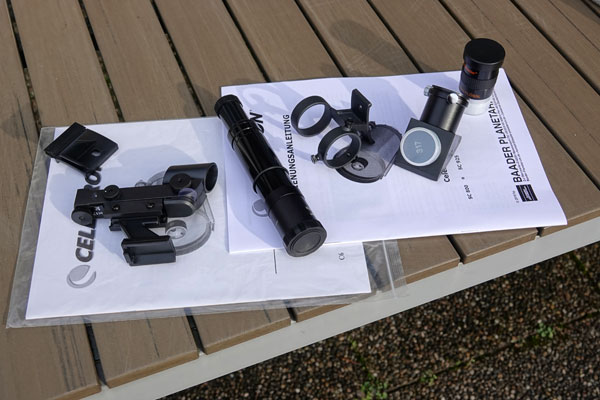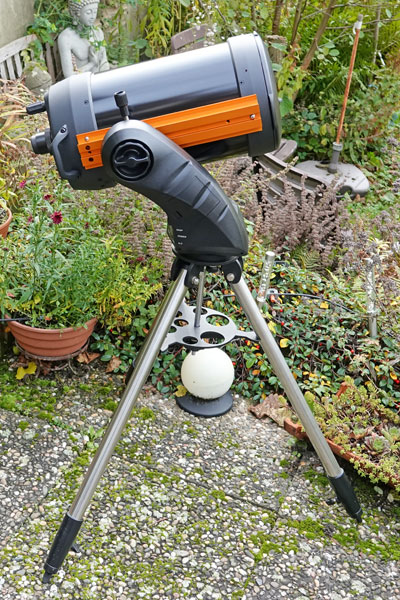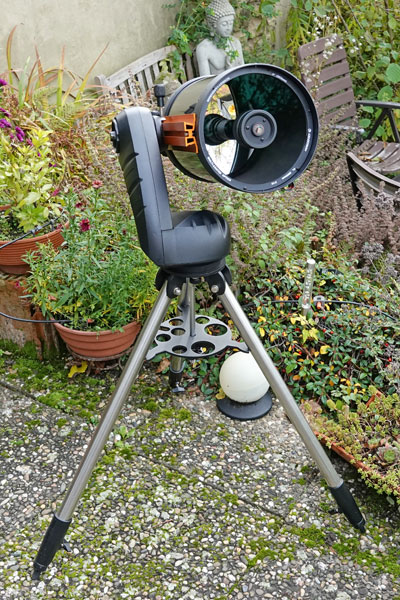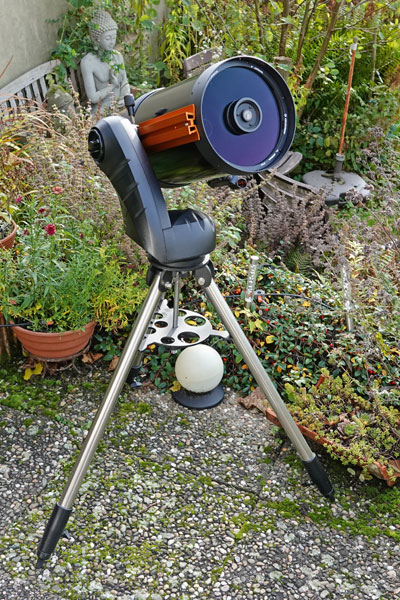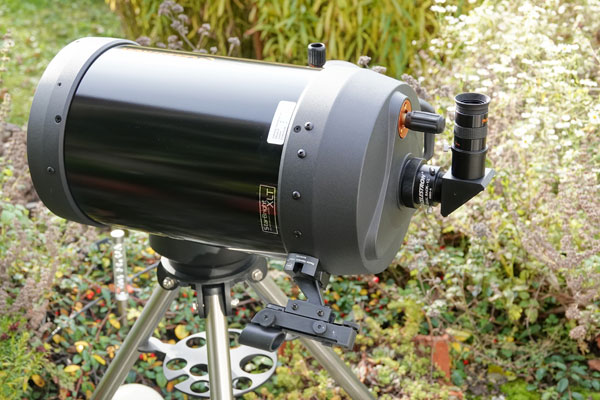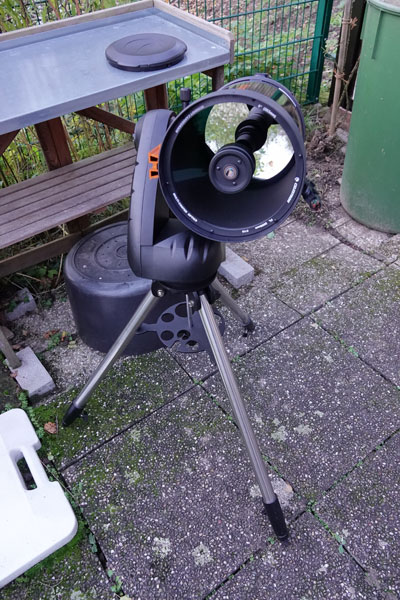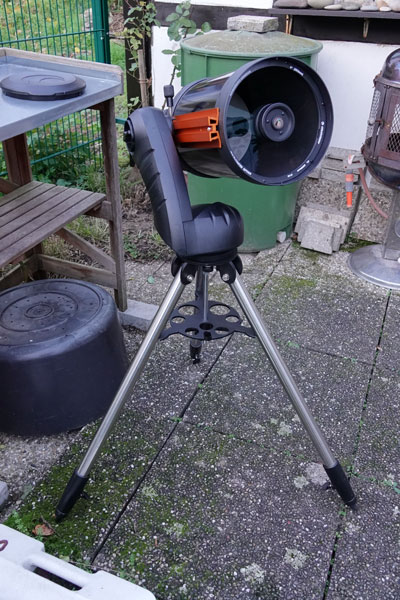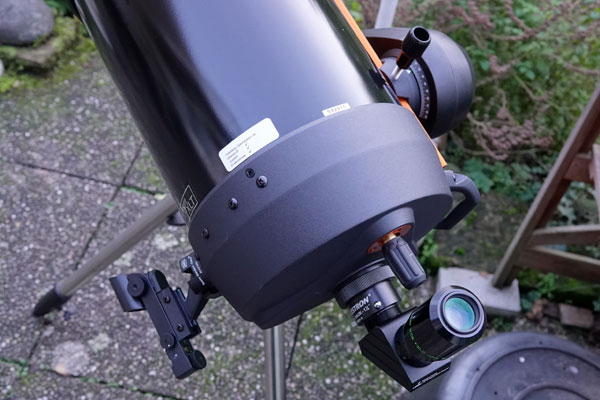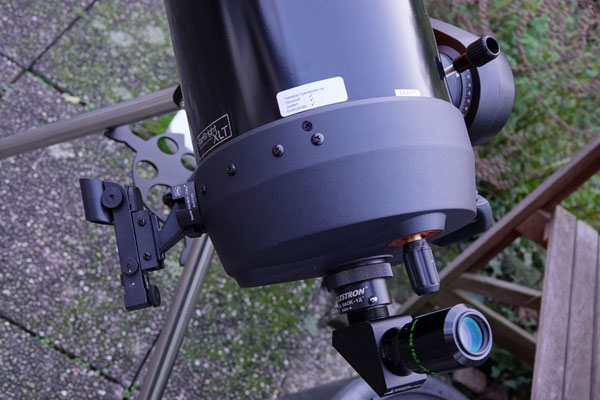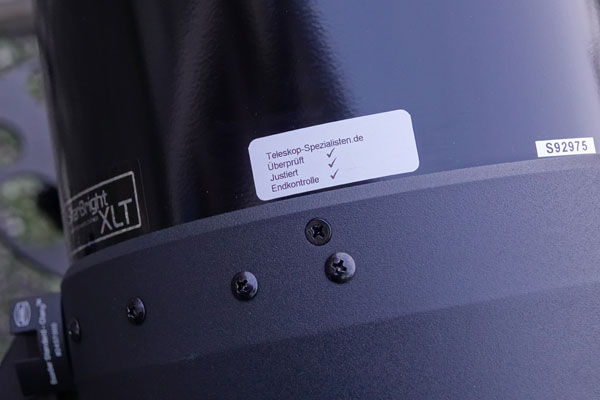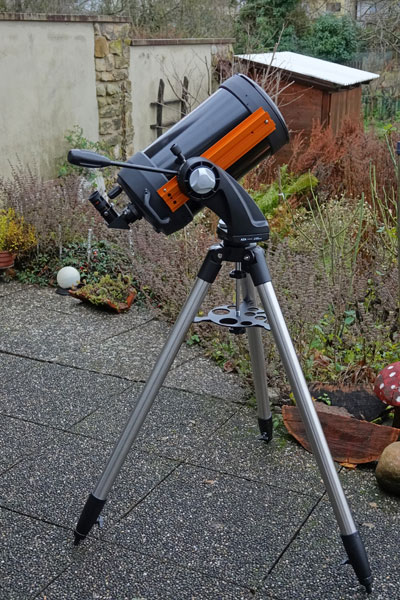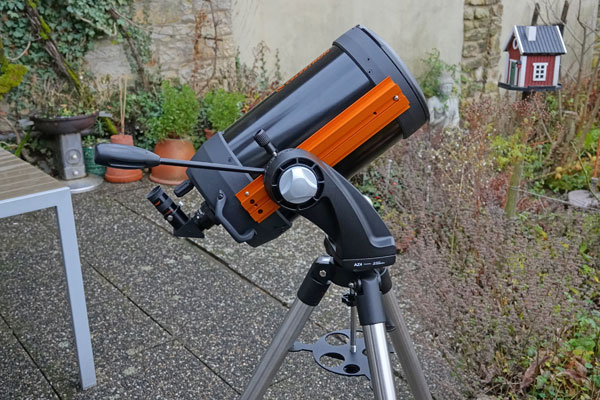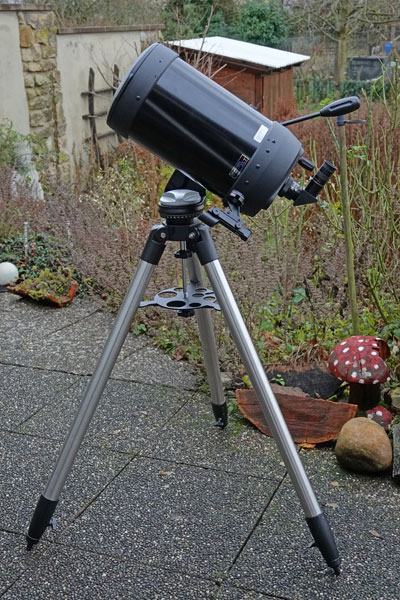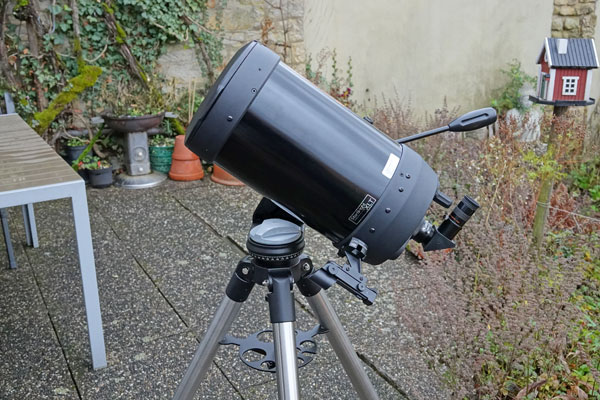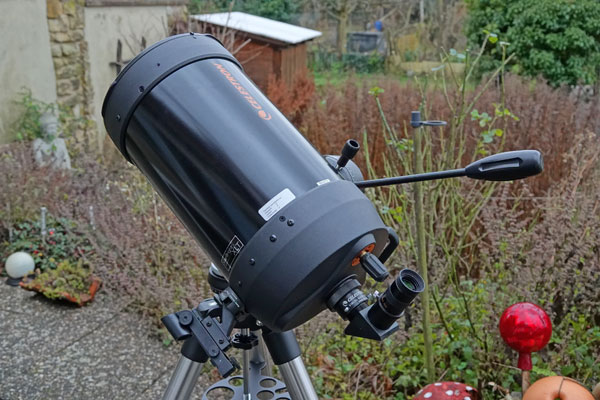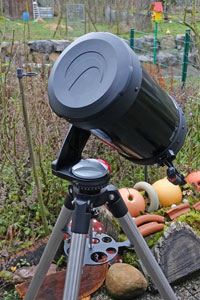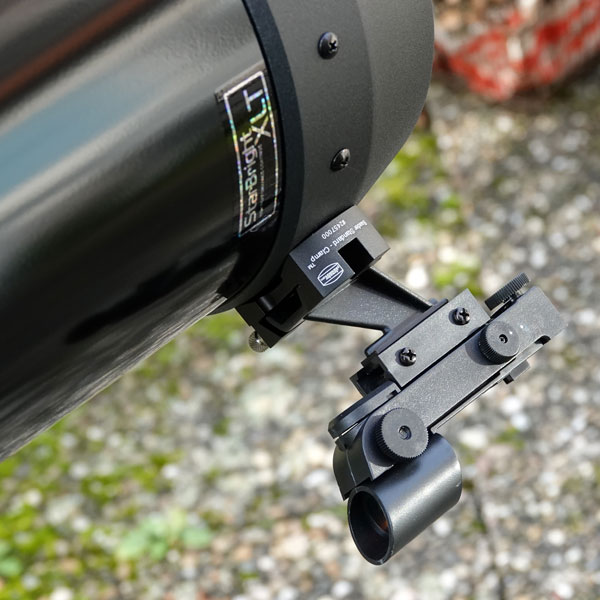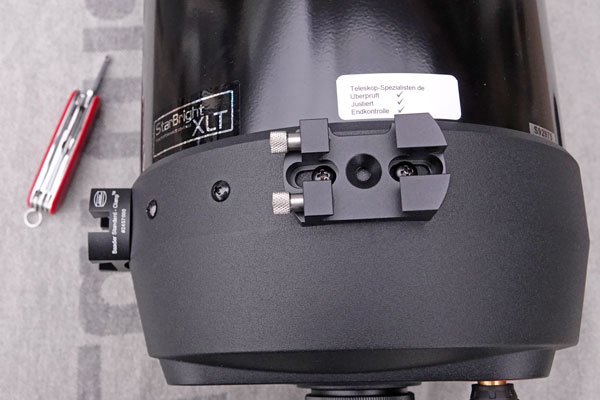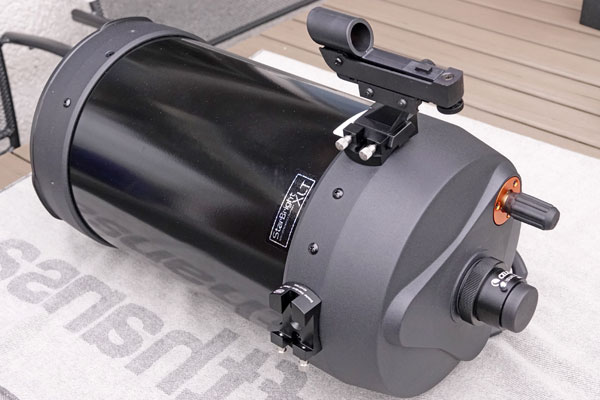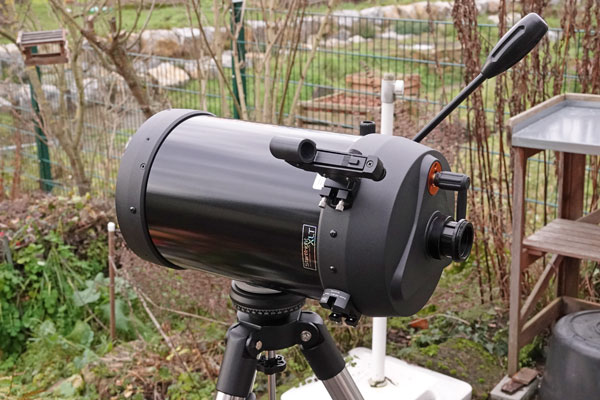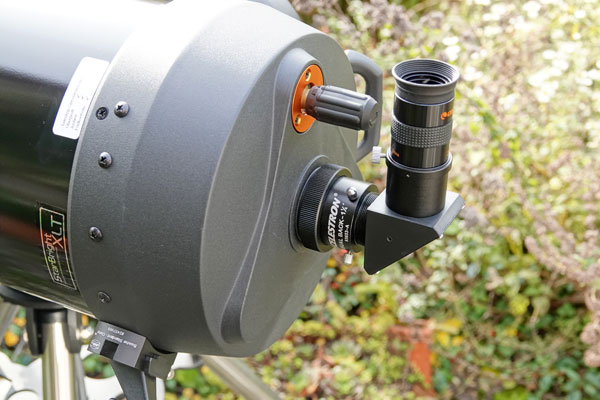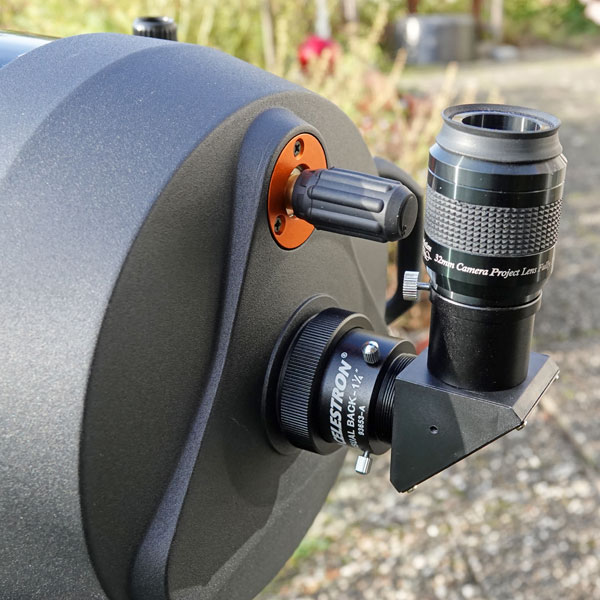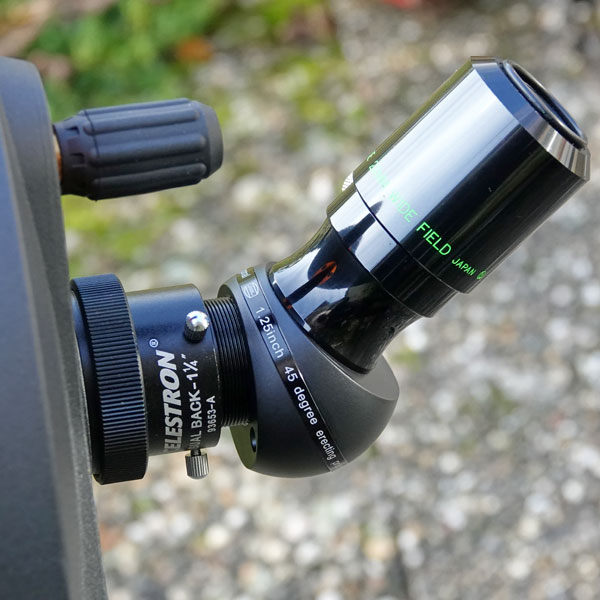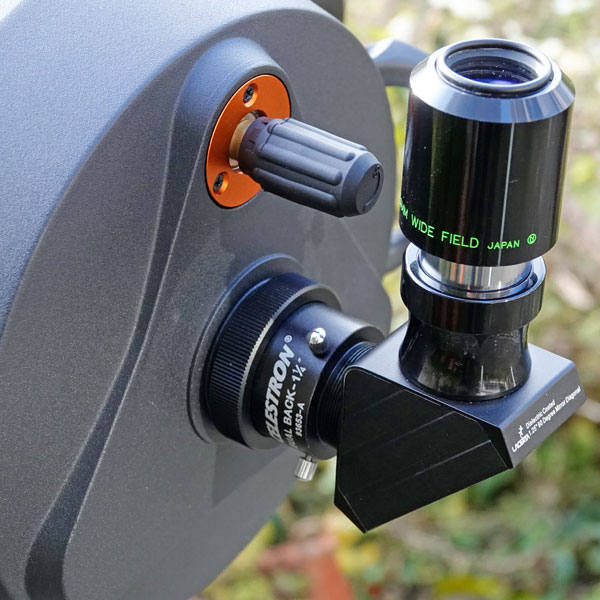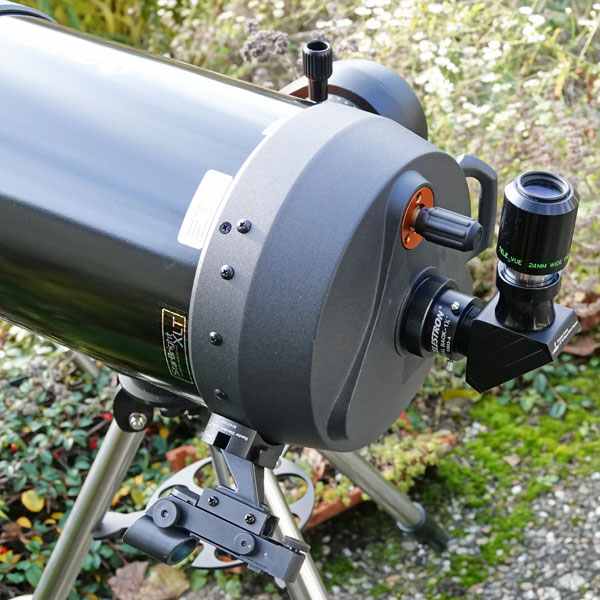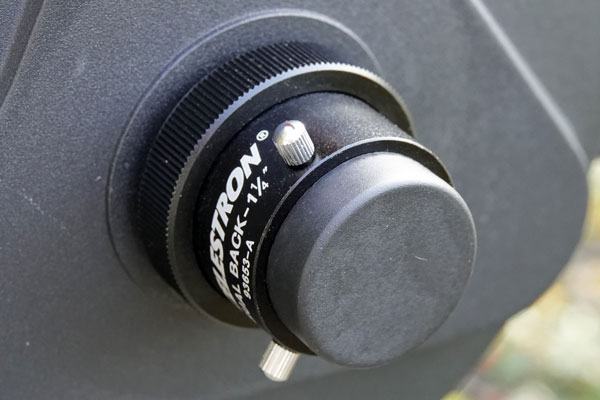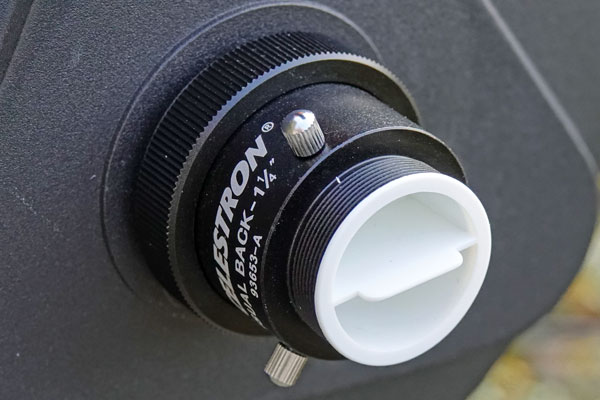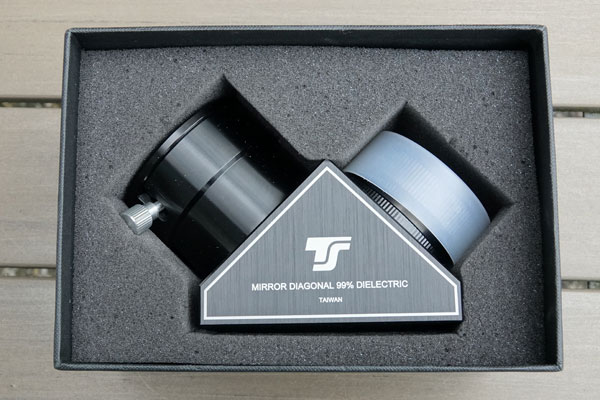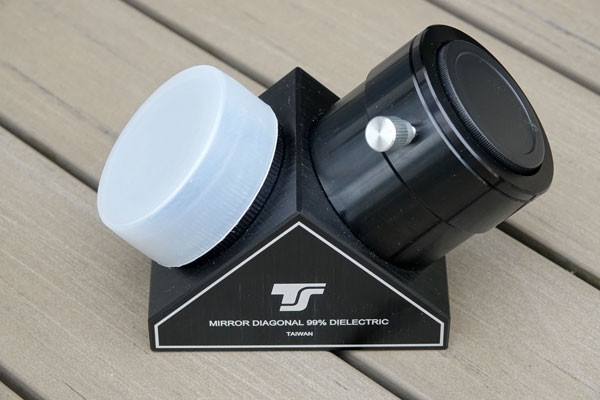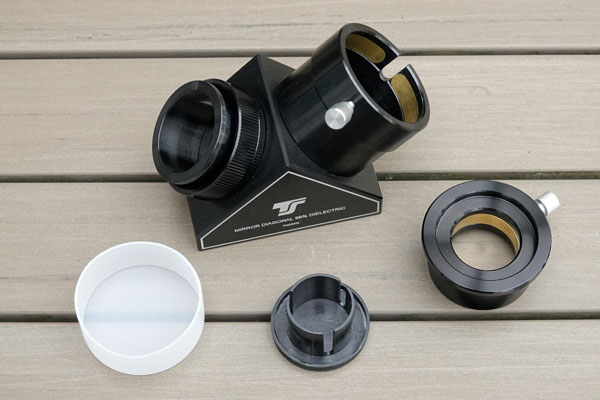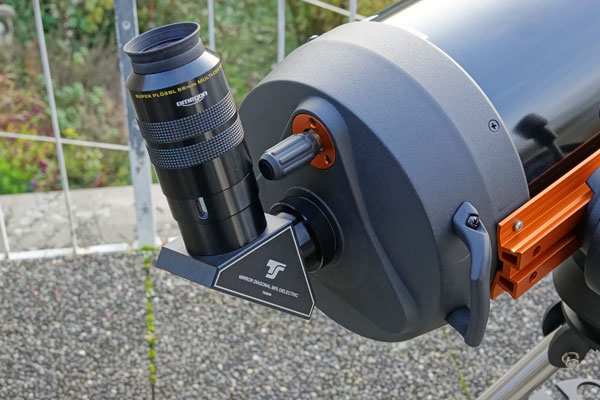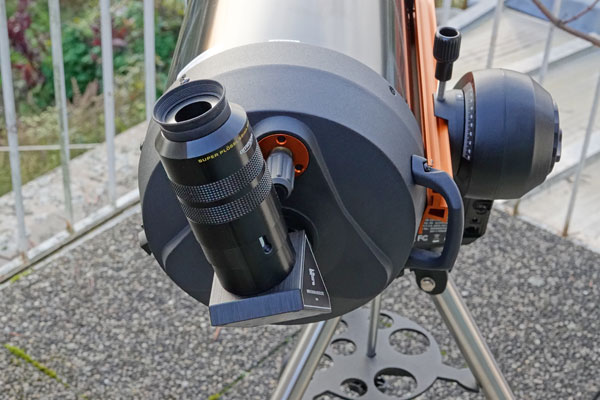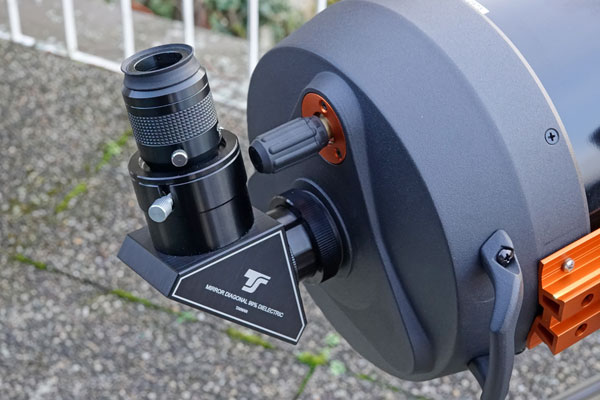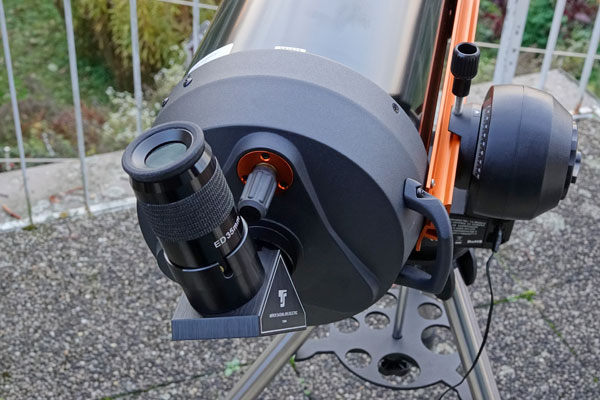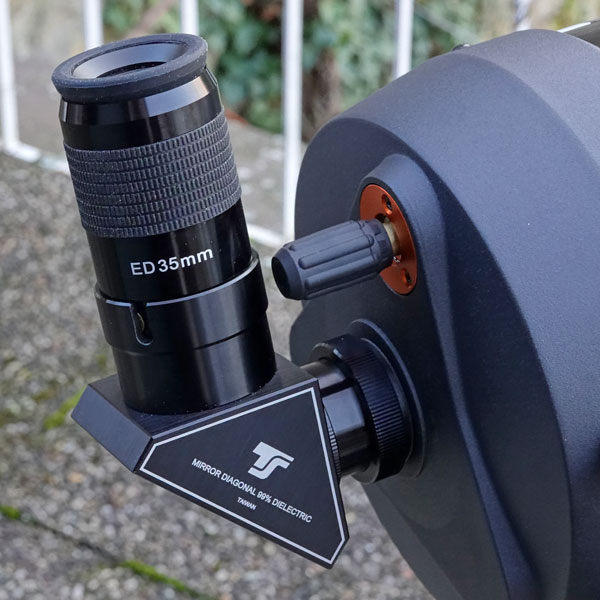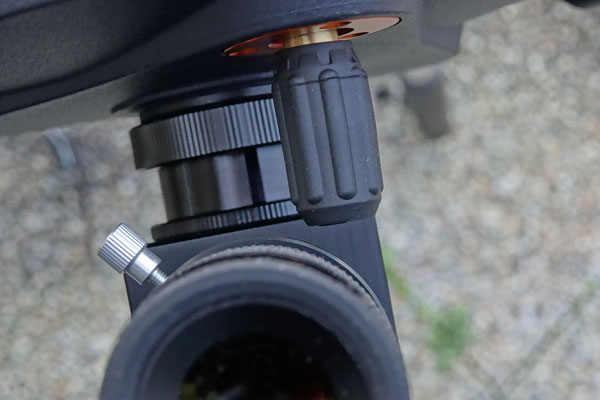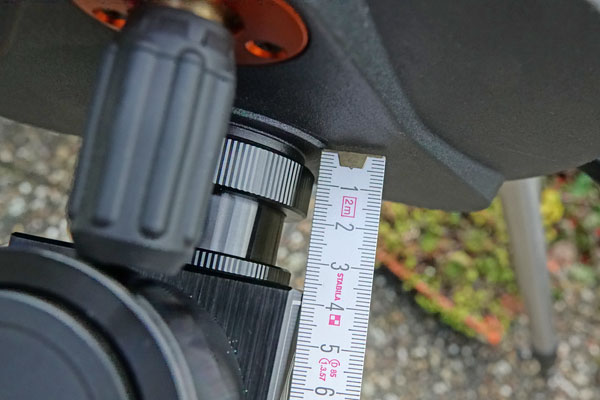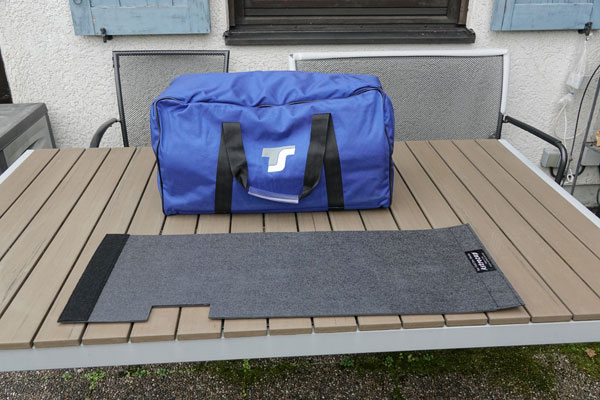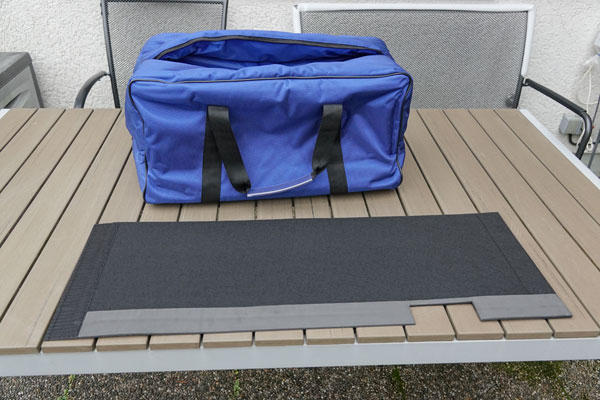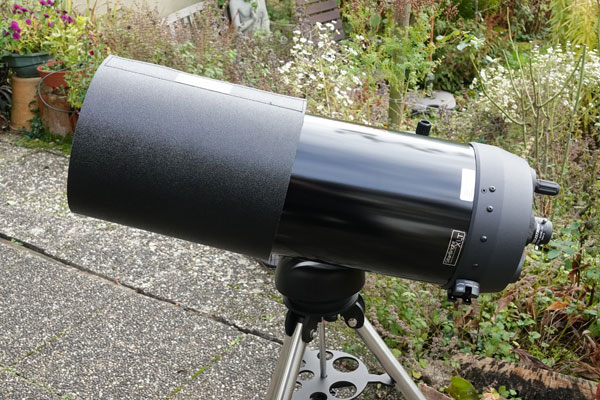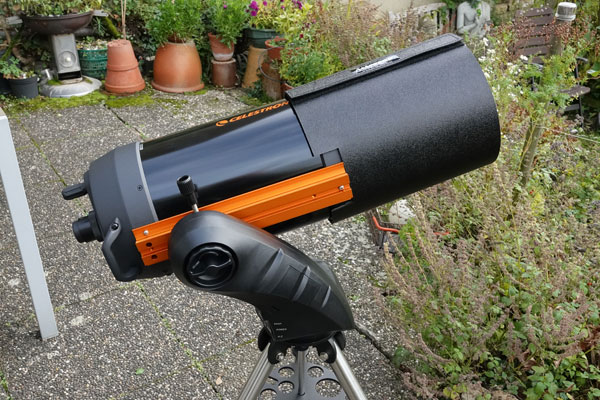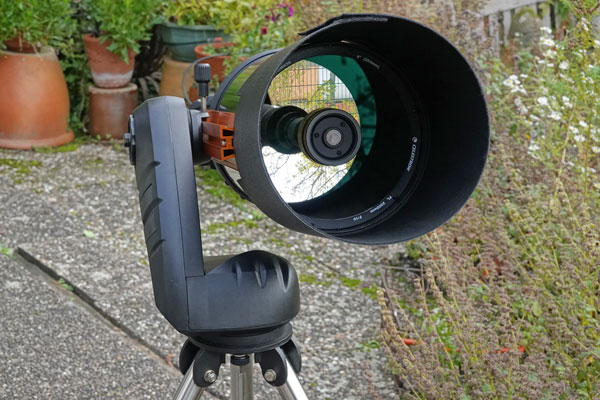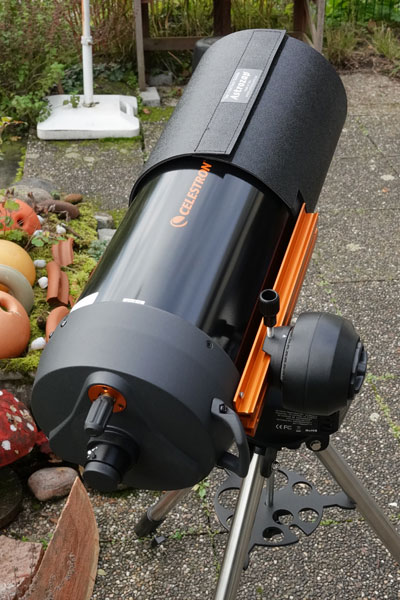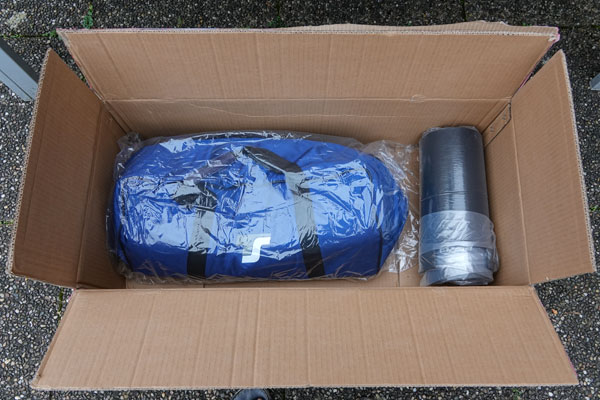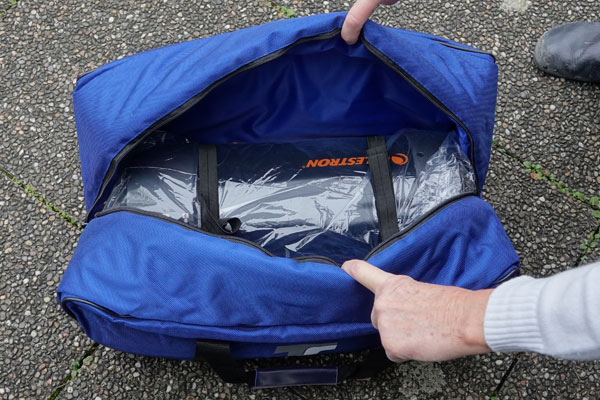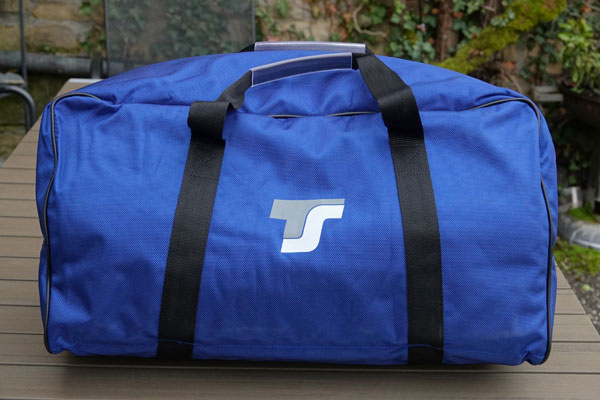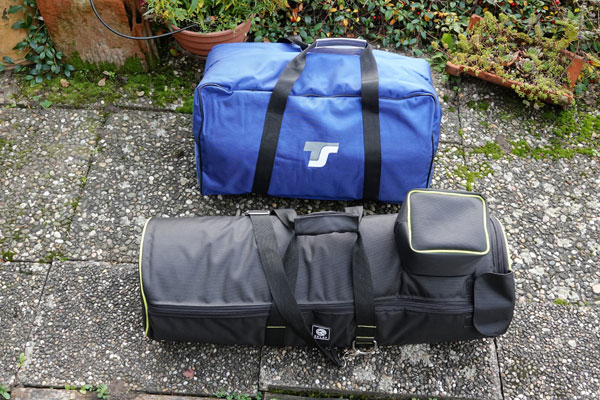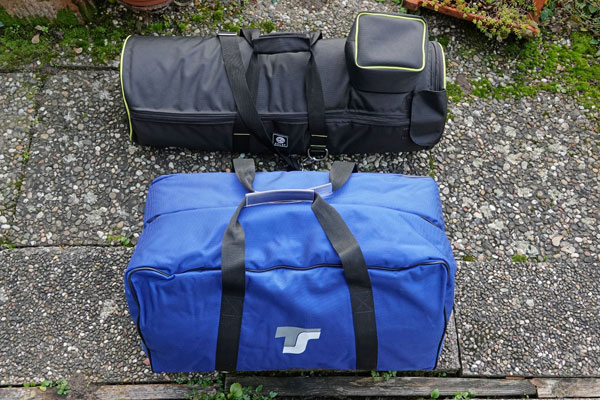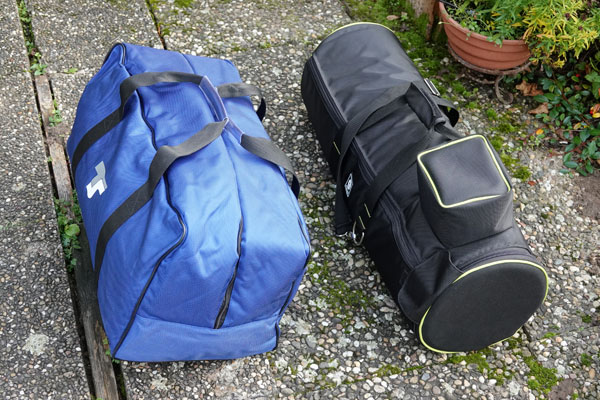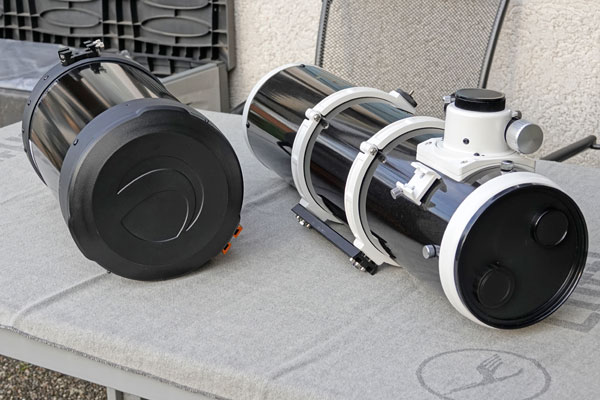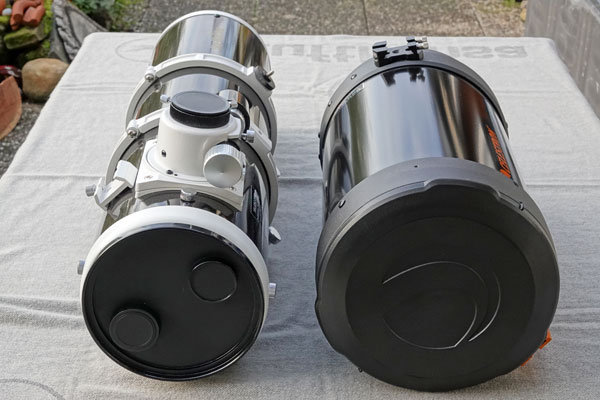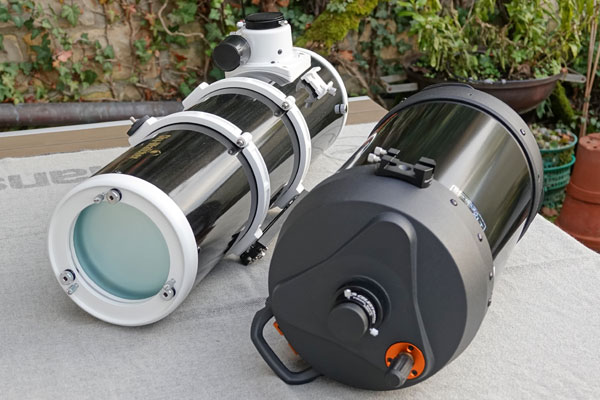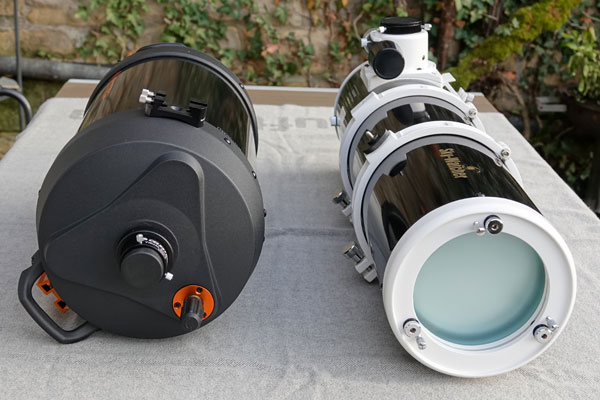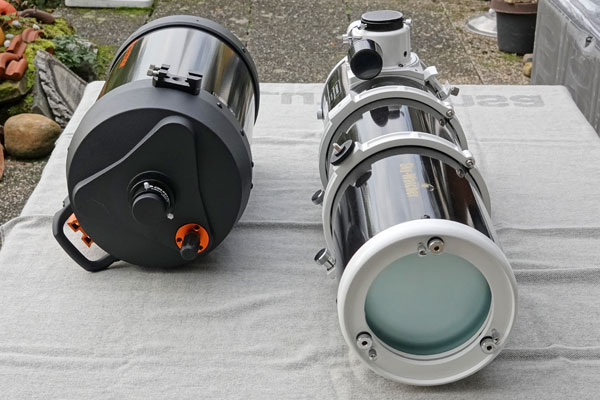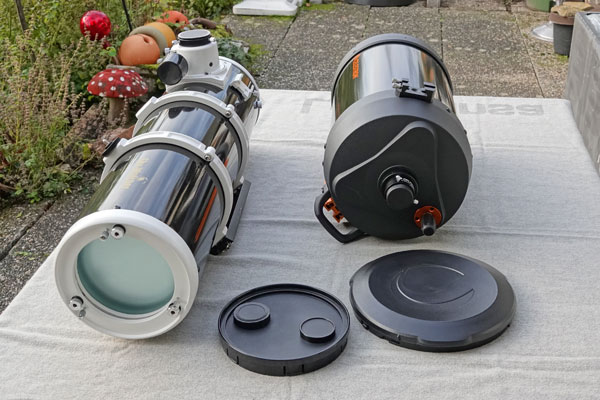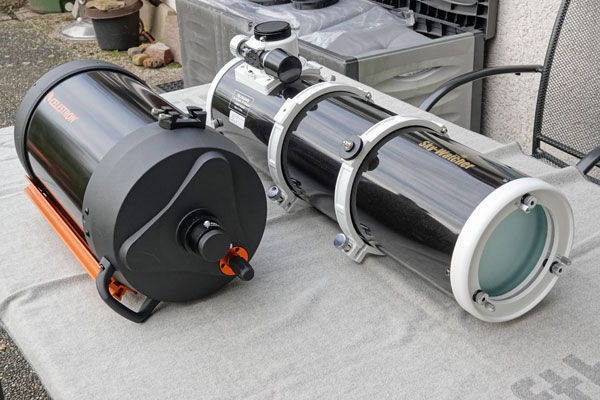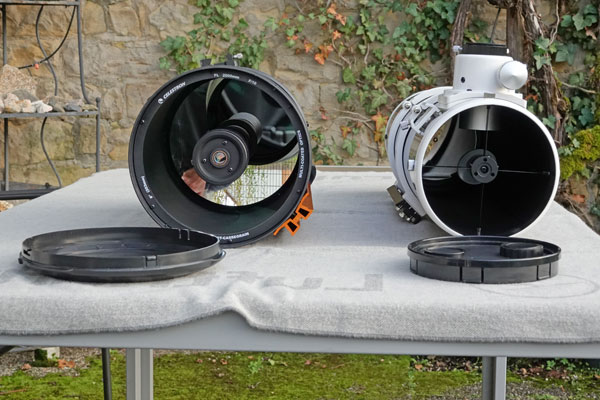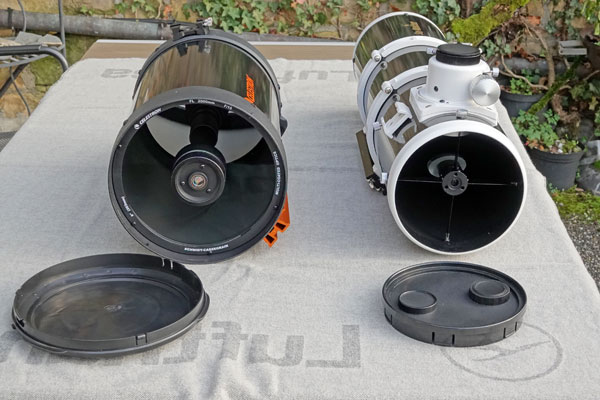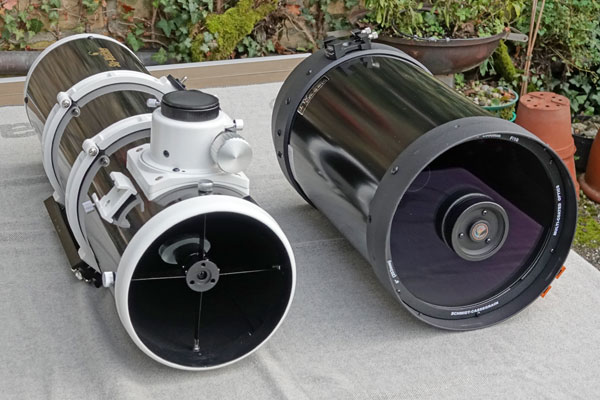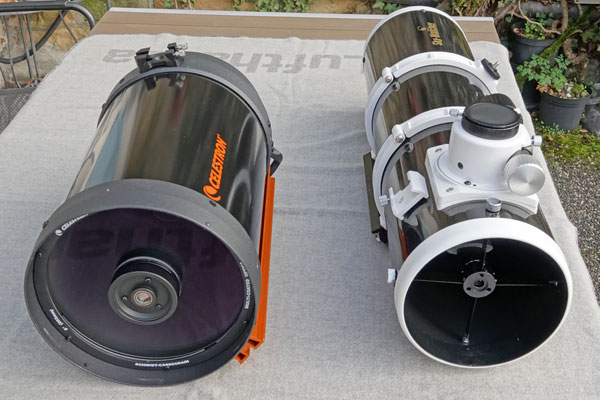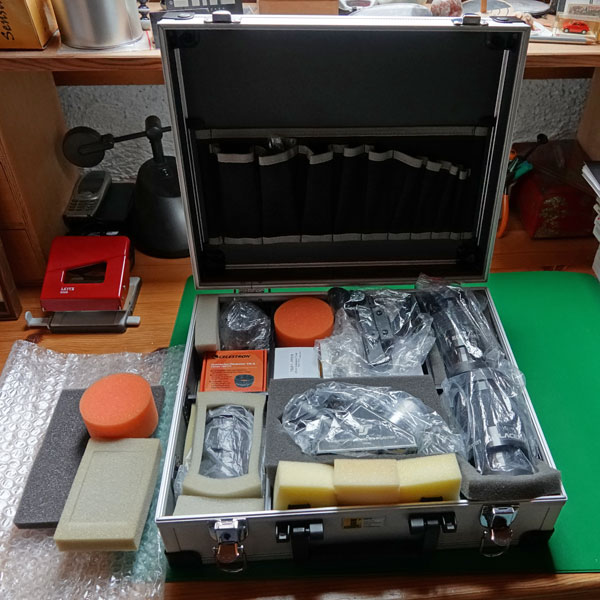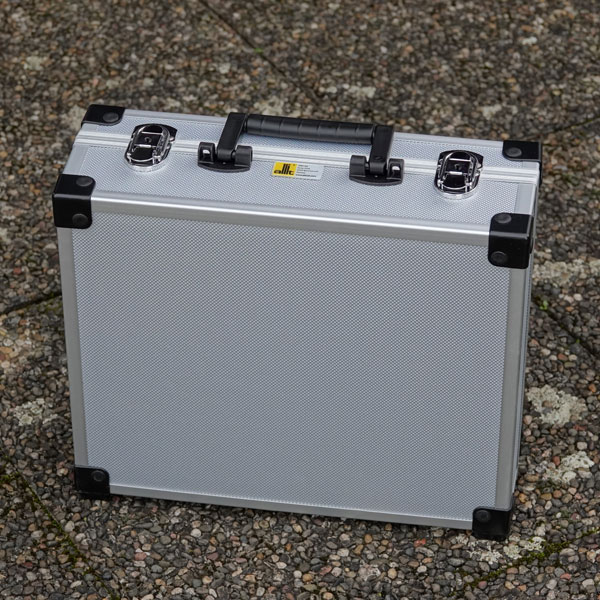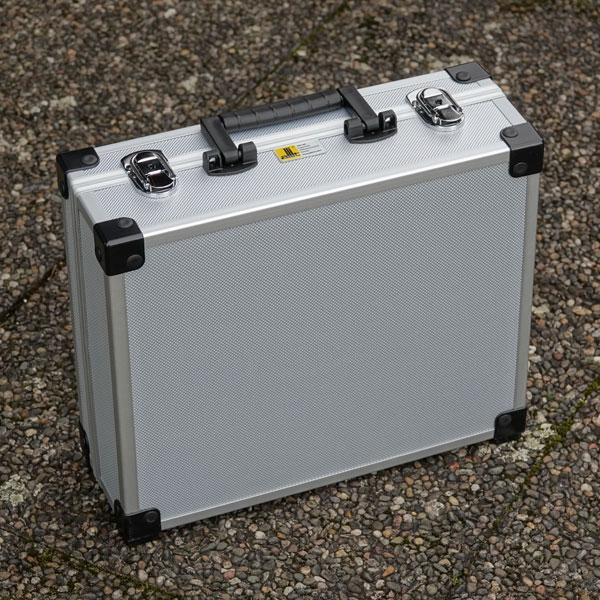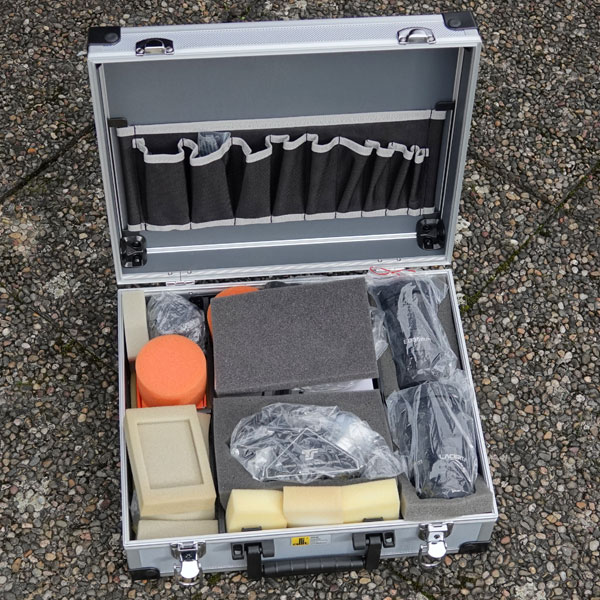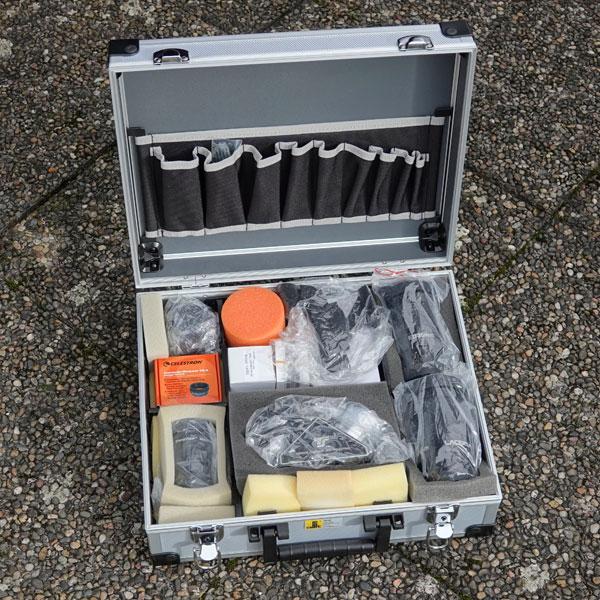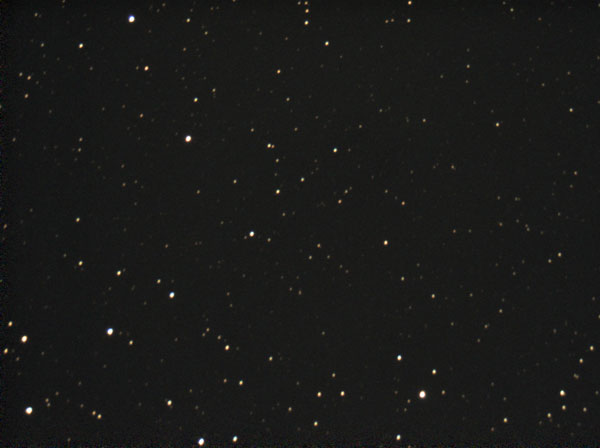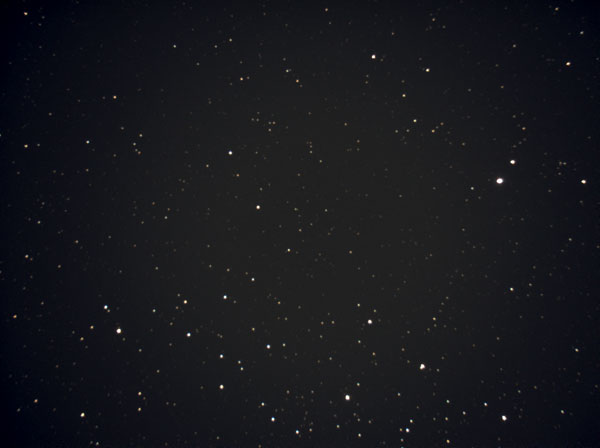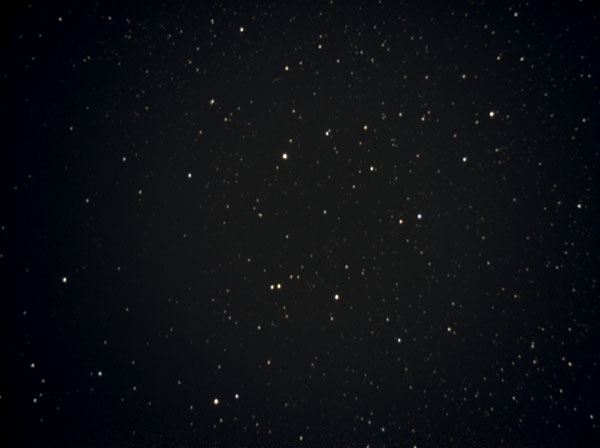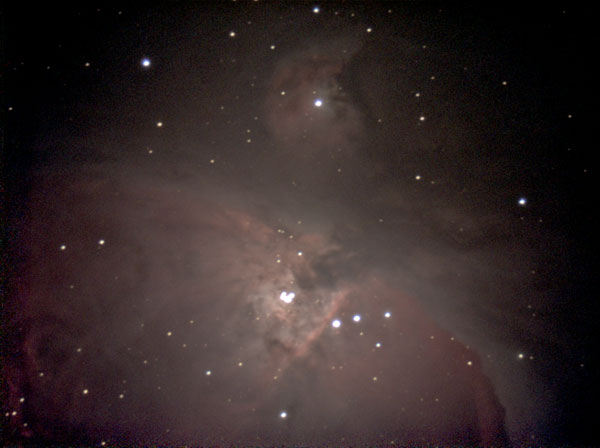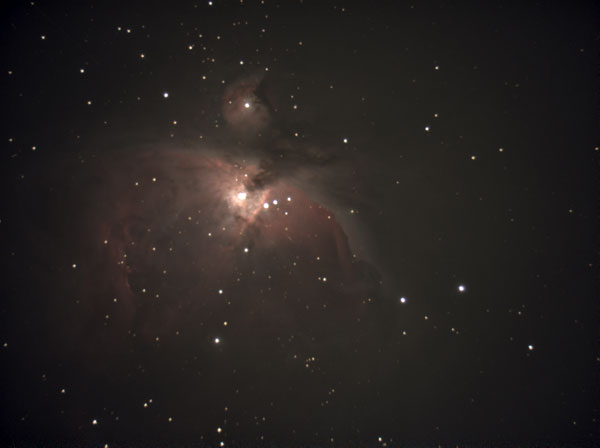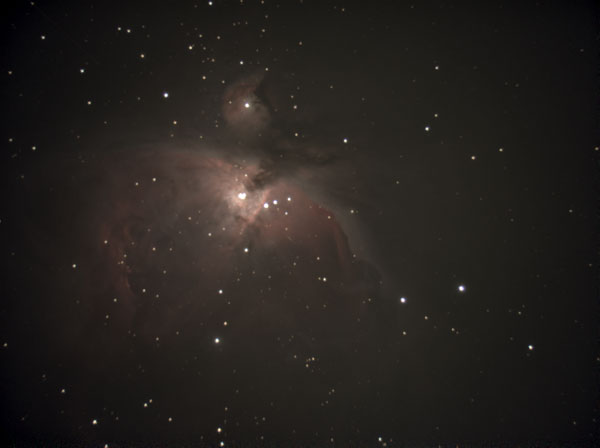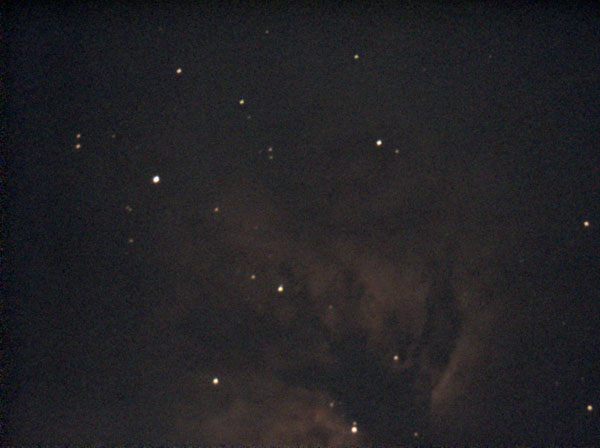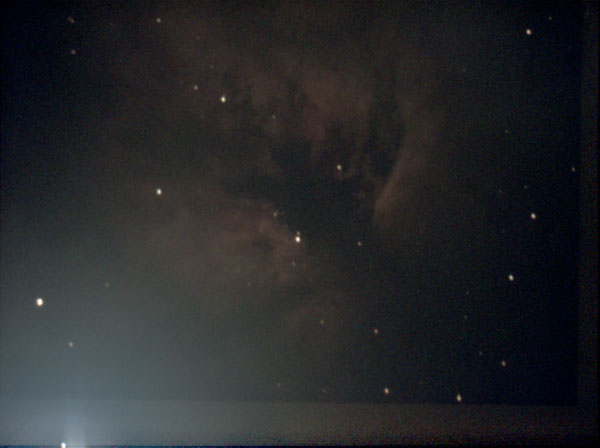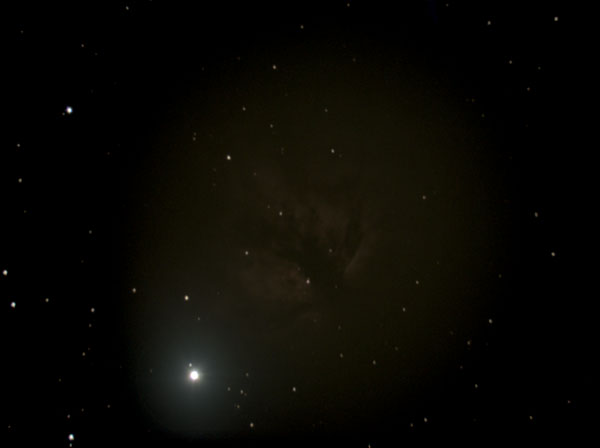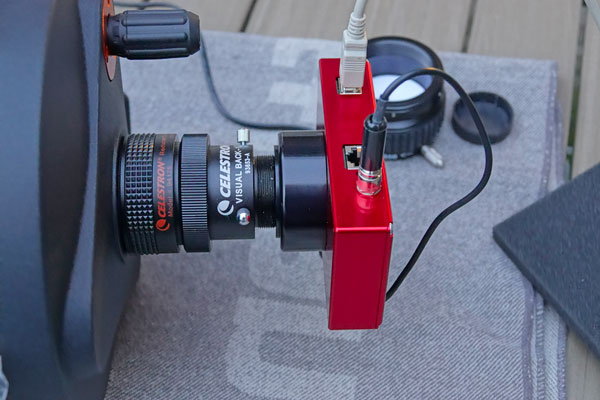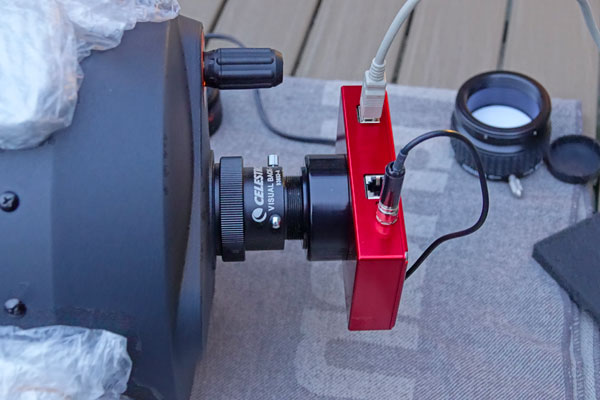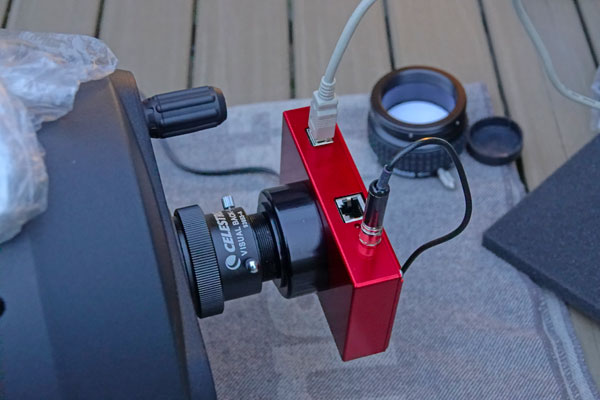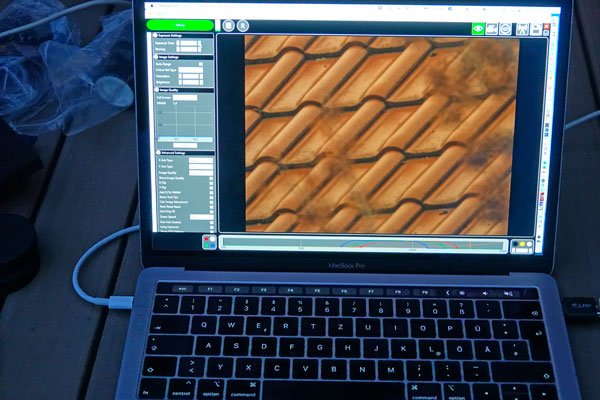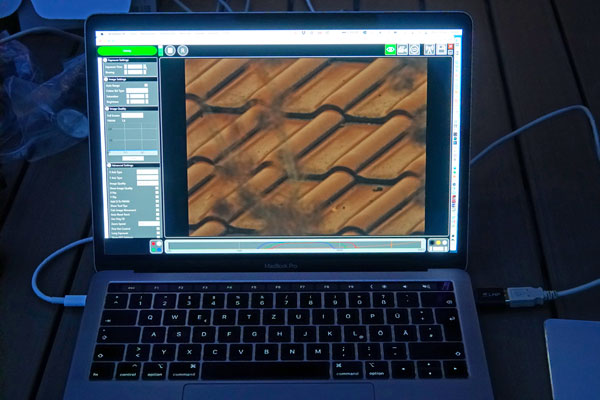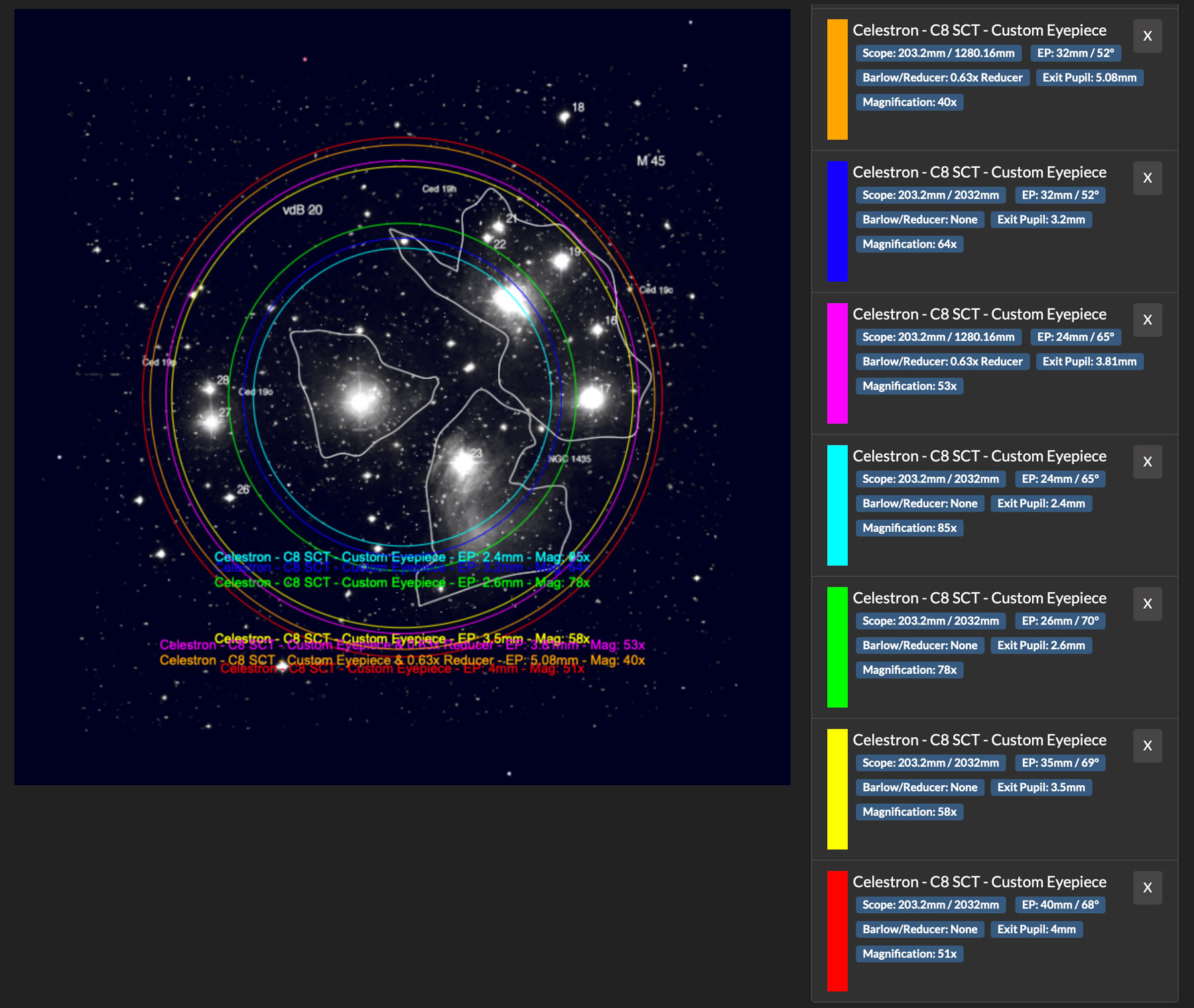Celestron C8 Information (8" Schmidt-Cassegrain)
Motivation | Look | Visited Sky Objects | First Experiences | Further Experiences, Issues, and Modifications | Photo Attempts | First Conclusions | Links | Appendix: FOVSimulations | Appendix 2: Data
Archive
On this page I provide some information about the Celestron Schmidt-Cassegrain-C8 OTA (ordered on November 8, 2019; received on November 14, 2019). This telescope is more or less my "final attempt" at owning a telescope with a large aperture that I still can carry and handle...
Notes:
- For changes to the "base model" see page C8 - Issues and Modifications
- For experiences with the f/6.3 reducer/corrector see page C8 - Reducer/Corrector f/6.3.
See the appendix for the data.
| Note: In the beginning of November 2022, I sold my Celestron C8 to a star friend, because I had used it only rarely. I therefore can no longer report any experiences with the C8 here. |
Motivation
Anyone who has read my astronomy history knows that I have quite a lot of "back and forth" behind me when it comes to telescope types and apertures. Actually, only a Schmidt-Cassegrain or pure Cassegrain telescope was missing in my collection. In September 2019, I came across a new Cassegrain telescope (GSO manufactures the various variants of it), and in the 6" variant it seemed to me to be the right telescope in order to further simplify my telescope collection. It might have replaced my Explorer 150PDS AND my Skymax-127 (except for deep sky photos and wide field observations). I would have preferred the 8" version, but this is too heavy for my Star Discovery mount and me... In the advertisements, the Cassegrain telescope was praised as being far better than Schmidt-Cassegrain telescopes, which on the other hand meant that these also came into my focus, although I had not been interested in them at all before. In addition, two of my star friends had bought exactly such telescopes, one had bought a Celestron C8, the other one a Meade LX200. Both telescopes are true "classics," but because the LX200 is a bit more expensive, I focused more on the C8. For me, its advantage seemed to be that it is an 8" telescope that weighs about as much as the new 6" Cassegrain telescope and is even a bit shorter. Thus, it looked to me like a "last chance" to regain aperture, after I had actually walked the "way back" from 10" to 6"... After all, aperture is "everything" in astronomy!
This would be the motivation behind my C8 purchase: More (manageable) aperture and a simplification of my telescope park in one act.
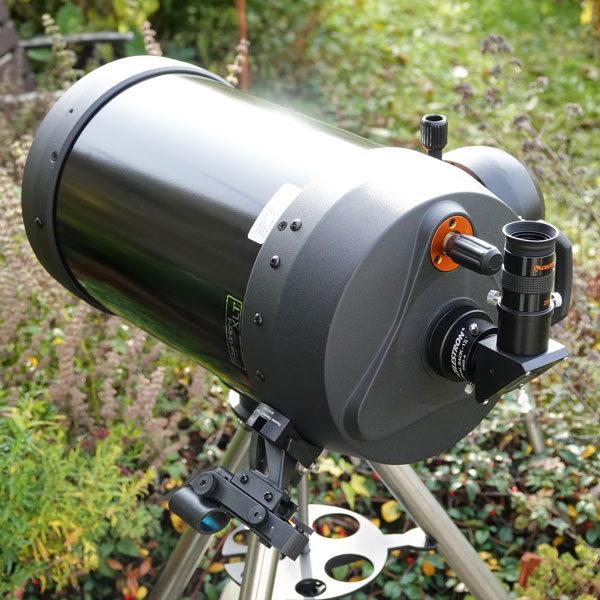 |
||
C8, side view on Star Discovery mount |
Ditto, front view |
Ditto, rear view |
The star friend owning the LX200 uses this on his Star Discovery mount, however, in the Orion version, which can carry 6 kg, at least on paper. But according to my astronomy dealer Mr. Kloß, the Orion version is identical to the Sky-Watcher version. This at least "suggested" that the C8 might also be used on my mount. In September/October 2019, I borrowed a Sky-Watcher StarTravel 120/600 from another star friend. We met for returning the refractor at the Stromberg hill and wanted to compare his C8, with which he is very satisfied, with my 6" Newton tube. Unfortunately, the upcoming clouds prevented this! At least, I was able to "weigh" the C8 and put it on my Star Discovery mount. There it seemed to be usable without any problems (at least, no more problems than with my 6" Newton tube, which has a similar weight but is longer).
So now I was confronted with two alternatives to change my equipment, Cassegrain 6" or C8 with 8" - and the third one was to do nothing at all. To clarify this, I wrote an e-mail to my dealer Mr. Kloß, from whom I would now also be able to buy the C8 at a particularly low price, and then called him on the phone. His e-mail reply made it clear that Cassegrains are difficult to collimate and have to be collimated often. I had already found similar remarks in discussion forums. So the Cassegrain was "out of the game" for me, and the C8 remained! During the phone call, Mr. Kloß was not able to "spoil" C8 for me. It is just a "universal telescope," which can do a lot, but is nowhere top. However, Mr. Kloß advised me to buy a used C8 despite his cheap offering - I would save about 500 EUR this way. We adjourned to about 14 days, because I wanted to go on a journey and take some time to think all this over. I searched for used C8s, but there were only few. These were of unknown age and seemed too expensive to me in comparison to the new price with Mr. Kloß. By the way, I had offered my star friend, who owns a C8 (which he bought used), to purchase it from him, but after much consideration he decided to keep it... So I finally called Mr. Kloß a little early from the North and ordered a C8. His "trademark" is that he checks and collimates telescopes before shipping them, so it took the C8 a little longer to arrive at my home, but on November 14 it did!
First Modifications at the Dealer's and Additions
I had Mr. Kloß modify the C8 tube in two aspects right on site: Firstly, I had a Vixen rail fitted in exchange for the 3" Losmandy prism rail, which is supplied as default. On the other hand, in exchange for the fixed finder, I had a Baader finder shoe fitted and ordered a red-dot finder in addition. Furthermore, I bought a simple TS carrying bag and soon after a dew cap. For all the changes to the "base model" see page C8 - Issues and Modifications, more about the finder and the bag below!
Look
Unboxing
|
Outer box |
Ditto |
Ditto |
|
Outer box opened |
Inner box opened |
Inner box taken out of the outer box |
|
Inner box opened, cardboard removed |
Ditto with cardboard and German manual |
Accessories and foam parts |
|
Telescope seen from above in box |
Telescope taken out of the box, english manual |
The box content |
|
Ditto, Vixen rail visible |
Manuals and accessories, to the left the additional red-dot finder |
Telescope, side view |
|
Telescope, oblique front view |
Ditto, rear view |
Ditto, oblique rear view |
|
Manuals and accessories |
Ditto |
Ditto |
Sizes and weights:
- Outer box: 58 x 32.5 x 38 (BHT)
- Inner box : 56 x 30.5 x 36 BHT
- Weight complete: 8.5 kg (own measurement, perhaps slightly more)
- Weight tube with caps: 5.6 kg (own measurement, perhaps slightly more)
C8 on Star Discovery Mount
C8 on Star Discovery Mount (in the Evening)
C8 on AZ4 Mount
 |
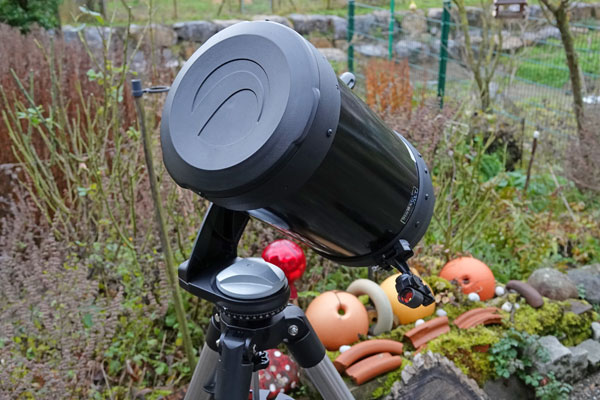 |
Red-Dot Finder, Eyepieces, Zenith Mirrors, and Amici Prism...
|
New finder shoe and red-dot finder (in awkward position) |
Second finder shoe; to the left, the finder shoe that was installed when I bought the telescope |
Finder mounted in the second finder shoe as a test |
Note: Later, I turned the finder
shoe around so that the finder foot fits the recess in the finder shoe
(I had initially mounted it in the same way as my astro dealer had mounted
it). |
||
|
Finder in the second finder shoe |
Original Celestron 25 mm Plössl eyepiece and Celestron zenith mirror |
32 mm Digiscope eyepiece |
|
24 mm Televue wide angle eyepiece |
Ditto on Amici prism |
Ditto on Lacerta dielectric zenith mirror |
|
Finder and eyepiece... |
Original cap for the 1,25" connection |
Alternative cap for the 1,25" connection (easier to remove, but does not protect the thread) |
|
2" SC zenith mirror (bought later) |
Ditto |
Ditto, pieces... |
|
2" zenith mirror with borrowed 56 mm eyepiece (2") |
Ditto, you can see that the zenith mirror is not mounted horizontally, but a little oblique... |
...because otherwise the tube for the eyepiece would touch the focusing knob; with 32 mm eyepiece and 2"-to-1.25" adapter |
|
Ditto with 32 mm eyepiece and 2"-to-1.25" adapter |
Ditto with 35 mm eyepiece (2"), read view... |
...and side view |
|
Ditto, larger |
You can see from above that the focuser might hits the eyepiece tube of the zenith mirror if you mount the mirror horizontally. |
Here, the focuser more or less hits the eyepiece sleeve of the zenith mirror - the SC adapter is only a little less than 4 cm long. |
Dew Cap
|
Dew cap flat, outer side |
Dew cap flat, inner side |
Dew cap put on |
|
Ditto, other side with recess for the prism rail |
Ditto front view Right: Ditto rear view |
Bag
|
Package with bag and dew cap |
Bag with C8 opened |
Bag with C8 closed |
Comparison with Explorer 150PDS
Bags (full)
|
Explorer 150PDS in black Oklop bag |
C8 in blue TS bag |
The TS bag's bottom is not flat... |
Comparison of the Tubes
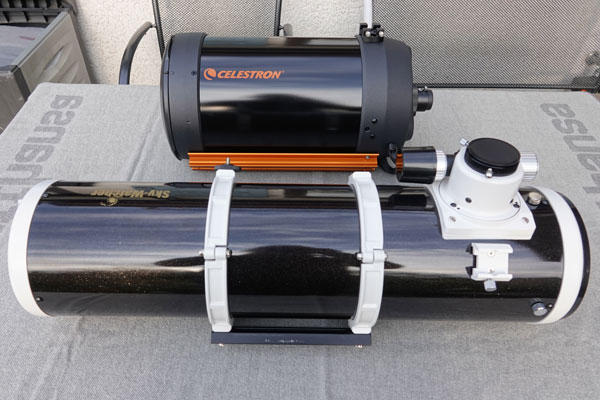 |
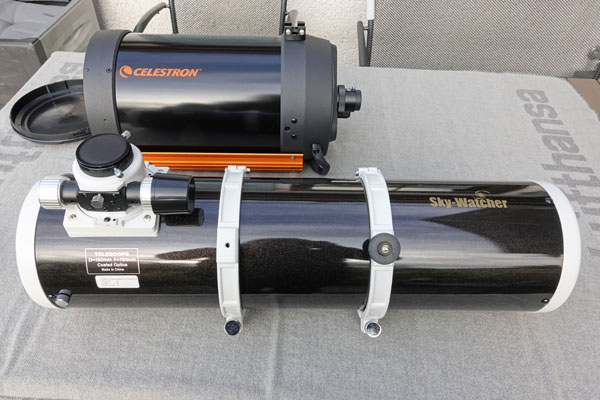 |
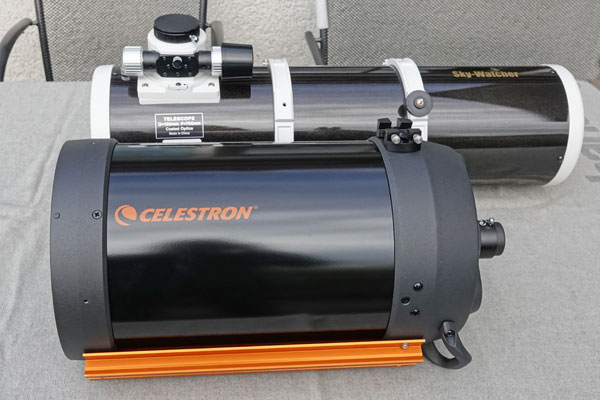 |
Visited Sky Objects
So far, I have visited the following sky objects with the Celestron C8:
- Moon (crescent, half moon with craters of 9 and 6 km diameters, Vallis Alpes, and more...)
- Venus (about half and a quarter), Jupiter, Saturn, Mars
- Comet C/2017 T2 (PANSTARRS)
- M 1, M 2, M 3, M 10, M 11, M 12, M 13, M 14, M 15, M 16, M 17, M 27, M 29, M 31, M 32, M 34, M 35, M 36, M 37, M 38, M 39, M 42/43, M 45, M 51, M 56, M 57, M 65, M 66, M 71, M 78, M 92, M 95, M 96, M 103
- Mel 25, NGC 457, NGC 663, NGC 752, NGC 884/869, NGC 2024, NGC 2903
- Double Stars: Albireo
First Experiences
Very First Impressions...
Size and Weight on the Star Discovery Mount
When I was handed over the parcel from the DHL parcel messenger on November 14, 2019, I did not find it as heavy as expected (it weighed about 8.5 kg). At a meeting with a star friend I could already "weigh" his C8 and found it not too heavy for me, but a bit heavy nonetheless. At home now, my C8 did not seem too heavy for me, and I was able to mount it on my Star Discovery without problems. It is indeed thick, but surprisingly short, which makes mounting easier for me.
Nevertheless, the C8 is already a "colossus" or whatever you might want to call it. It already arouses a little awe, or even fear in me. No, that is definitely not a Heritage 100P which is easy to handle! On the Star Discovery mount the C8 looks "monstrously", but that was not completely new for me, because I was already able to see and try it at the meeting with my star friend. And another star friend had sent me photos of his LX200 on this mount, and that looked like equally overloaded...
When the starfriend, whose C8 I had already been able to test on the Star Discovery mount, saw my photos of my configuration, he was probably a little unsure as to whether this combination was indeed "workable". In reality the mount did not appear as overloaded as in the photos. He then immediately looked around for alternatives for my mount, for example the new Meade LX65 mount, which, however, can just carry as much (or little...) as the Star Discovery mount.
Overall, I can carry the C8 tube (5.7 kg) at least as well as the Explorer 150PDS tube, although the latter may be slightly lighter (5.5 kg); but its length makes it harder for me to handle. Inserting the C8 into the prism rail also works smoothly, probably also because the tube is quite short (approx. 45 cm). I also find the handle at the back very practical, with which you can carry the tube around (but probably without accessories...).
Finder and Finder Shoe
The Celestron C8 is supplied with a fixed finder and, depending on the model variant, either a magnifying or a red-dot finder. This finder is not removable and does not fit in small pockets. I therefore asked Mr. Kloß, from whom I bought the C8 tube, to replace the existing finder with a standard finder shoe and a red-dot finder. After having inserted the tube into the Star Discovery mount, I noticed immediately that the finder shoe comes to lie at the bottom left (like with the Skymax models). Of course, this is not ideal! I describe my search for a better solution on page C8 - Issues and Modifications!
|
Left and Center: in its original position the finder is located at the bottom left of the tube when it is used on the Star Discovery mount |
The same applies to the AZ4 mount |
Bag
Mr. Kloß had advised me against buying a bag, but I had not listened to him. Maybe, I should have done that! The bag is the right size for the tube, but squeezing the tube in and out requires four hands! And when the tube is in the bag, the bag is round at the bottom and does not lie properly on the floor - there is no reinforcement at the bottom. Pulling out the rubber bands to secure the tube is not an easy task, either. When closing the closures, the straps slip easily out of my hands, because the straps are so strong. Well, they will surely wear out over time...
The 2" Zenith Mirror and Its Delights...
Mr. Kloß had advised me to first go with the 1.25" Zenith mirror provided with the C8 and to wait and see to which extent the mirror shifting will disturb me. As a remedy, one might install a 2" focuser for fine focusing, and this would make a specific 2" zenith mirror for the C8 superfluous. But after one week I bought a 2" zenith mirror with SC thread from a starfriend, who bought such a focuser... This way, I was able to test the 2" eyepieces that he borrowed me for evaluation (plus my own 2" eyepieces).
When I mounted the zenith mirror for the first time (22.11.2019), I noticed that the eyepiece tube of the mirror would collide with the focus knob if I mount the mirror exactly horizontally. So I mounted it a little bit oblique for a start! In addition, I tightened the threaded ring much too tight, so that I could remove it from the tube only with the help of a rubber blanket. Unfortunately, the mirror has to be removed after observations. Otherwise the tube does not fit into my bag - I bought a bag that is too small for including the zenith mirror! So I put the 1.25" back on again at the beginning, whenever I put the tube into the bag... This was cumbersome, and so I looked for better solutions for all this and found them: Baader ClickLock clamp and pure 2" zenith mirror. For more on this topic, see page C8 - Issues and Modifications!
Very First Impressions at the Sky
Nearly "First Light"...
On November 24, 2019, I had certain hopes that I would be able to observe one or the other DSO between the clouds. But except for Vega in the 35 mm and 56 mm eyepieces, I could not see anything and disappointedly repacked the telescope...
A Somewhat "Distributed First Light"...
On November 27, 2019, we returned home later, and in the sky the Orion appeared in the east - sometimes completely and sometimes only partially. So at home I set up the C8 as fast as possible on my Star Discovery mount and operated it with the handbox (without alignment). Unfortunately, my efforts were not crowned by too much success, because always clouds appeared and finally put an end to my observation attempts. Nevertheless, I was able to observe the Orion Nebula M 42/43 and the Pleiades M 45, which I visited when the Orion Nebula was covered by clouds. It seemed to me as if I had never seen the Orion Nebula so beautifully in a telescope before (28 mm, 35 mm, 56 mm), at least as long as it was not covered by clouds. Not only the "wings" (the nebula looks like this for me...) were nice to see, but also the Trapezium. However, my wife never managed to get to the telescope in time when there was a gap in the clouds... I also liked the look of the Pleiades M 45 in the C8 a lot!
On November 29, 2019, we drove to Erkerode near Braunschweig, and I tried out the C8 at the globular star cluster M 15 in Pegasus with a lot of eyepieces. When using long focal length eyepieces (56 mm, 38 mm, 35 mm, 32 mm), I noticed the bright core, which was surrounded by a glowing region. M 15 was also beautiful with my 28 and 24 mm eyepieces (73 x and 84 x). At a magnification of a little more than 100 x, M 15 was already quite large (18 mm, 16 mm), but I was not yet able to resolve the cluster into stars. This was achieved at a magnification of 200 x (10 mm), but only with averted vision. But the cluster had already a discernible structure. After supper, I tried to find the globular cluster M 2 in the constellation Aquarius, which is located below M 15, but I was not able to find it. Then clouds appeared and put an end to my attempts.
On November 30, 2019, I observed the crescent moon in Erkerode and compared some of my own and borrowed eyepieces until the moon set. Once again, I did not manage to observe the globular star cluster M 2 due to upcoming clouds. Later the sky became clear again, and we observed the Orion Nebula M 42/43 until clouds appeared again. Thereafter, we observed the Pleiades M 45, which were higher up in the sky and therefore still free from clouds. When observing the moon, the tube was perhaps still too warm, the view "flickered", and I had problems with focusing. M 42/43 was very nice at the beginning, but then looked fainter and fainter. M 45 was also nice, but too large for the field of view.
On December 2, 2019, I once again observed the slightly larger crescent of the moon and compared some of my own and borrowed eyepieces using the moon. That was it for that day...
First Impressions
On December 4, 2019, we had half moon, and I used the half moon on the one hand for further eyepiece comparisons at the half moon, and also for searching visually for two small craters. So far, I had only looked for small craters on photos. On this day, I was also able to find M 2 (Aquarius) and observe it with different eyepieces (up to a magnification of 200 x). But the half moon brightened the sky so much that even at the highest magnification I was not able to resolve M 2 into single stars. At least, I was able to see the bright core nicely at lower magnifications. Then I observed M 15, which in fact was very similar to M 2 and led to about the same results. Later, I observed the Orion Nebula M 42/43, then the Pleiades M 45, thereafter the galactic reflection nebula M 78, and finally once again the Orion Nebula M 42/43 using diverse filters.
Half Moon
- With respect to the half moon, I have to note that my wife and I had the impression to have never seen it before so beautiful, that means, rich in contrast and detail, as with my 35 mm eyepiece on that day. In the 24 mm eyepiece it was beautiful as well and filled the field of view optimally.
- Later, I searched for two small craters visually using a 10 mm eyepiece (and a longer one before that) and determined their names and sizes in the Virtual Moon application: (1) Ammonius in crater Ptolemaeus - 9 x 8 km, (2) Albategnius C in crater Albategnius - 6 x 6 km.
Globular Star Clusters M 2 and M 15
- First I observed the globular star cluster M 2 in different eyepieces (56, 35, 28, 24, 18, 16, 10); at long focal lengths, the bright core was clearly visible; even at magnifications from 100 x to 200 x it was not possible to resolve the cluster into single stars, probably because of the full moon. The sky background was relatively bright, because the moon still was located to the left of M 2/M 15.
- Then I observed the globular cluster M 15 in different eyepieces (56, 35, 28, 24, 18, 16, 10); basically, it was very similar to M 2; at long focal lengths the bright core was clearly visible; a resolution into stars was not possible even at magnifications from 100 x to 200 x, probably because of the full moon.
- The borrowed Explore Scientific 18 mm eyepiece was well usable for observing M 2 and M 15!
Orion Nebula M 42/43
- M 42/43 seen well with different eyepieces (56, 38, 35, 32, 28, 18 mm) despite the half moon; at the end, it got better and better (the sky behind Orion was relatively dark then, the setting moon did not disturb much anymore). Beautiful "wings" and the trapezium also seen well. M 42/43 seen well with a focal length of 28 mm at minimum, 18 mm already enlarged too much.
- At the end (the moon had almost set) I tried out three borrowed filters: I did not find any effect for the Light Pollution and the O III filter, but the UHC filter (actually just a contrast filter for fighting light pollution...) exposed the Orion Nebula even better (especially Astrid found this; but maybe her eyes were not completely dark-adapted before...) - and astroshop.de also mentions this for the UHC filter...
Pleiades M 45
- Saw always only a section of the Pleiades M 45; I could wander along a little for more (by moving the telescope)... Used only eyepieces with a long focal length, saw a shimmer around the brighter stars.
- Did not find any differences between the 32/35/38 mm eyepieces except for the field of view...
- Regarding the blur at the edges of the field of view, I also found no differences except at the beginning of my observations (maybe the 32 is a little bit blurrier at the edges than the other two eyepieces).
Galactic Nebula M 78
- For the first time, I saw the galactic reflection nebula M 78 well: a roundish "shimmer" (nebula) and two stars within it at the top; this allowed me to identify M 78 unambiguously.
- I used different eyepieces, but did not enlarge M 78 too much, because it in that case became too faint (28 mm was the shortest focal length that I could use well).
- I was not able to find the Horsehead Nebula B 33...
Summary
The observations of this day (and partly of the previous days) led to an overall pleasing result:
- We believe that we saw the half moon in the C8 with 35 mm eyepiece more beautifully than ever before - but in any case very well.
- We have definitely never seen the Orion Nebula M 42/42 as well as with the C8, especially when using the UHC filter.
- The Pleiades M 45 were also nice, but are actually already too large for the field of view in the C8.
- We saw the M 78 well for the first time, and without much effort. Even with my 8" Dobson, I did not manage to achieve that (but, of course, I cannot remember how dark the sky was then).
A Suitcase for the Accessories
In February 2020, I bought an aluminum suitcase for the C8 accessories in a hardware store (this was a tip from my astronomy dealer Mr. Kloß). But the accommodation of the accessories is still quite provisional...
Accessories: three 2" eyepieces Red-dot finder f/6,3 rducer/corrector etc. |
Further Experiences, Issues, and Modifications
I will report further experiences with the Celestron C8 on a new page, because this page has already become much too long. The same applies to issues and modifications that I describe on page C8 - Issues and Modifications.
For experiences with the f/6.3 reducer/corrector see page C8 - Reducer/Corrector f/6.3.
Diameter of the Rear Baffle
In the Cloudy Nights thread Rear Opening Sizes of Celestron SCT OTAs, I found the following values for the rear baffles of the Celestron tubes:
- C5: 25 mm
- C6: 27 mm (elsewhere*, I found the values 26 mm, 25 mm, and "like the C5")
- C8 38 mm
- C9.25: 45 mm or 48mm
- C11: 54 mm
- C14: 54 mm
*) How to calculate Maximum Field of View in c6 SCT (please scroll through the thread)
I therefore looked into the back of the C8 myself (January 21, 2021) and tried to measure the diameter of the port (a long thin tube called rear baffle...) - and can confirm a diameter of 38 mm.
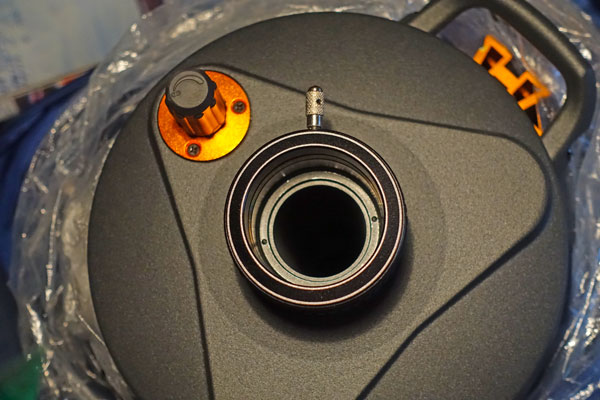 |
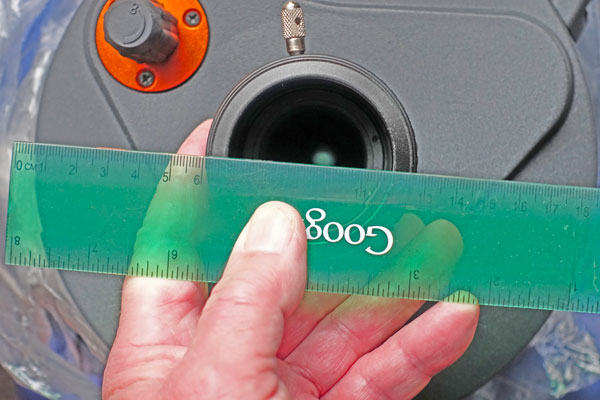 |
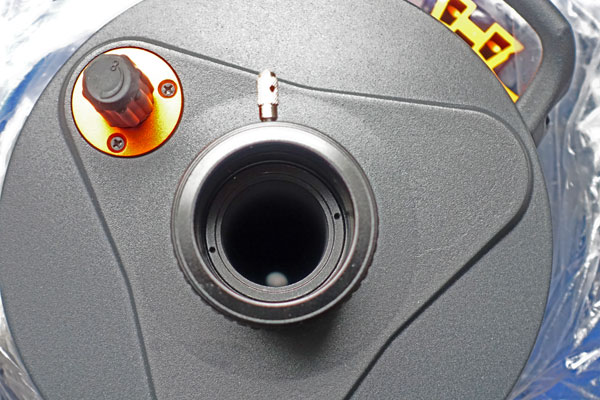 |
||
Back of the C5 tube: A long tube with a diameter of 3.8 cm becomes visible |
The parallax makes it hard to estimate the diameter. |
Another attempt at daylight on the following day... |
Photo Attempts
April 23, 2020: Crescent of the Venus
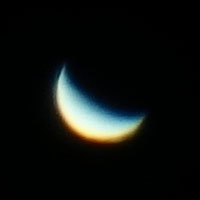 |
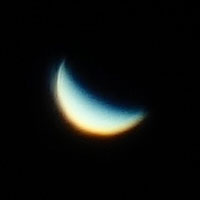 |
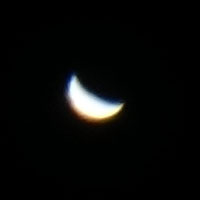 |
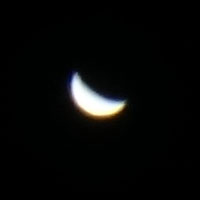 |
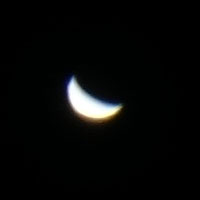 |
||||
Crescent of the Venus taken with mit C8 and RX100 M4 |
||||||||
March 15, 2020: A Nightly Test with the C8
On 15.3.2020, I made a first "night test" with the Atik Infinity camera at the Celestron C8. I tested the following two configurations: (1) f/6.3 reducer/corrector and 1.25" zenith prism, (2) f/6.3 reducer/corrector, 0.5x TS focal reducer (screwed into the camera) and 1.25" zenith prism. The telescope was mounted on the Star Discovery mount, which I operated with the SynScan WLAN module via the SynScan app on the iPhone. Here are some of the "best" photos I took during this test session:
All in all I found the results, apart from those for M 42/43, fairly disappointing, but I was not that much in practice anymore... Faint objects like the Flame Nebula NGC 2024 were very pale, which did not get much better in post-processing (even though they were saved as 16 bit TIFF files). I got vignetting with the additional 0.5x TS focal reducer, which is more or less annoying depending on the object. On the other hand, you get a much larger field of view (about 0.8° against 0.4°, thus about 48' against 24'; the latter fov does not even capture the moon as a whole).
Dry Runs with Atik Infinity
In a number of "dry runs " (December 2020) I checked again and several times, whether the Atik Infinity camera can be operated at the C8 with and without reducer/corrector and without further equipment, that is, only with the 1.25" visual back. This was indeed the case (even if this somewhat contradicts older tests...). Below are some example photos:
|
C8 with 1.25" Visual Back and f/6.3 Reducer/Corrector |
C8 with 1,25" Visual Back |
C8 with 1,25" Visual Back |
|
Result for photo above |
Result for photo above |
First Conclusions
Overall, I do not regret the purchase of the C8, and the results so far make me curious about what will be possible with the C8 in the future!
I soon found a more convenient solution for the zenith mirror: the combination of a Baader ClickLock clamp for SC connection with a pure 2" zenith mirror. And by adding a second viewfinder shoe, I can now mount the finder in a more comfortable position depending on the mount used. For details see page C8 - Issues and Modifications.
I present my experiences with the Celestron f/6.3 reducer/corrector on page C8 - Reducer/Corrector f/6.3. Essentially this is still trial and error...
The purchase of an AZ4 mount in December 2019 allowed me to use the C8 manually without hassles (before that I had used it manually on the Star Discovery AZ GoTo mount or just with the handbox without GoTo...). But in then end, I did not really become happy with the AZ4 (cumbersome assembling; no flexible shafts for simple tracking); so I decided in January 2021 to replace it with a GSO GSAZ mount; this was, however, never delivered...
It also looks as if the Atik Infinity camera can be operated at the C8 with 1.25" visual back and with/without f/6.3 reducer/corrector. I did not use the ZWO ASI224MC (acquired Aptil 2021, sold mid-April 2022) at the C8 because of the small field of view.
Note: In the beginning of November 2022, I sold my Celestron C8 to a star friend, because I had used it only rarely. I therefore can no longer report any experiences with the C8 here.
Links
- Celestron - C8-A XLT (CGE) Optical Tube Assembly: www.celestron.com/products/c8-a-xlt-cge-optical-tube-assembly
- Celestron Germany - 8" SC-XLT tube (OTA) with 3" rail (76mm): www.celestron.de/ce_de/astronomie/teleskope-(otas)/c8-a-xlt-(cge)-ota.html (in German)
- Sky-Watcher AZ4 Mount Information
- Sky-Watcher Star Discovery AZ GoTo Mount Information
- See also my page offering Astronomy Links.
Appendix: FOV Simulations
Visual Observing
For the C8, I used the astronomy.tools Field of View tool to demonstrate how certain longer focal length eyepices compare regarding the field of view using M 45 (Pleiades).
Here you can see quite well that with 1.25" eyepieces (orange) and f/6.3 reducer/corrector a similar maximum field of view can be achieved as with 2" eyepieces (red). The 26 mm eyepiece with 2" is then again in the range of the long focal length 1.25" eyepieces without reducer/corrector. In the end, this confirms what I read, namely that you actually only need one eyepiece in the long focal length range, at least as far as the FOV is concerned.
Imaging
For the C8, I used the astronomy.tools Field of View tool to demonstrate the field of view with my current and past cameras (and without/with f/6.3 reducer/corrector):
The Atik Infinity has about twice the FOV of the ZWO ASI224MC, the ZWO ASI 294MC even four times the FOV of the ASI224MC. The f/6.3 reducer/corrector nearly doubles the FOV compared with no reducer/corrector.
Appendix 2: Data for Celestron C8
Technical Data
| Telescope: Celestron | C8 |
| Optical Design | Schmidt-Cassegrain |
| Primary Mirror Diameter | 203.2 mm (8") |
| Focal Length, Focal Ratio | 2032 mm, f/10 |
| Resolving Power (arc secs) | 0.57" |
| Limiting Visual Stellar Magnitude | 14 mag |
| Light Gathering Power | 842.7*/841/843 |
| Maximum Practical Visual Power | 406 x |
| Optical Tube Dimensions (diam. x length) | 23.8 x 43.2 cm |
| Net Weight Basis | --- |
| Net Weight Optical Tube | 5.67 kg |
| Net Weight Complete | --- |
Dark Blue: Telescopes that I still own; italic and dark red: telescopes that I owned; black: for comparison; *) own measurement/calculation; **) corrected values
See also the table of data for all of my telescopes (and a few more...)
Observation-Relevant Data (in Comparison with my 6" Newton Tube)
| Telescope | Focal Length (mm) |
Aperture (mm) |
Focal Ratio |
Light Gathering Power |
Maximum+ |
Minimum* |
Maximum* |
Minimum+ |
|||||
Usable Magnification |
Usable Focal
Length of Eyepiece (mm) |
||||||||||||
Factor/Exit Pupil (mm) > |
Manuf. |
1.5 |
2 |
6.5 |
7 |
6.5 |
7 |
1.5 |
2 |
||||
| Celestron C8 (Schmidt-Cassegrain) | 2032 |
203.2 |
10 |
842.7 |
305 |
406 |
31.26 |
29.03 |
65.0 |
70.0 |
6.7 |
5.0 |
|
| Cel. C8 (Schmidt-Cassegrain) (Red.) | 1280 |
203.2 |
6.3 |
842.7 |
305 |
406 |
31.26 |
29.03 |
41.0 |
44.1 |
4.2 |
3.2 |
|
| Celestron C5 (Schmidt-Cassegrain) | 1250 |
125 |
10 |
319 |
295/300 |
188 |
250 |
19.23 | 17.86 | 65.0 |
70.0 |
6.7 |
5.0 |
| Cel. C5 (Schmidt-Cassegrain) (Red.) | 787.5 |
125 |
6.3 |
319 |
295/300 |
188 |
250 |
19.23 | 17.86 | 41.0 |
44.1 |
4.2 |
3.2 |
| Skymax-102 (Maksutov-Cassegrain) | 1300 |
102 |
12.75 |
212 |
153 |
204 |
15.69 |
14.57 |
82.9 |
89.3 |
8.5 |
6.4 |
|
| Skymax-127 (Maksutov-Cassegrain) | 1500 |
127 |
11.81 |
329 |
191 |
254 |
19.54 |
18.14 |
76.8 |
82.7 |
7.9 |
5.9 |
|
| Explorer PDS150/Dobson 6" | 750 |
150
|
5 |
459 |
225 |
300 |
23.08 |
21.43 |
32.5 |
35.0 |
3.3 |
2.5 |
|
*) Calculated for an exit pupil of 6.5 mm and 7 mm
+) Factor 1.5 or 2 for Dobsonian/Newtonian telescopes; in general, the lower
value of 1.5 is used for Newtonian telescopes; if the manufacturer specified
a different magnification, it is also listed (some manufacturer provide considerably
higher numbers...).
Visual Power (Magnification) and Other Data for Different Focal Lengths of Eyepieces (Mostly My Current Eyepieces)
Note: These tables include the StarTravel 120 refractor, a TSWA32 eyepiece (2", 32 mm focal length, 70° viewing angle) that I borrowed together with the StarTravel 120, a 18 mm eyepiece (2", 82° viewing angle), a 38 mm eyepiece (2", 70° viewing angle), and a 56 mm eyepiece (2", 52° viewing angle).
I did not include the Celestron 25 mm Plössl eyepiece, which is delivered with the C8, because I gave it away...
| Magnification | Focal Length of Eyepiece (mm) |
|||||||||||||||
| Telescope | Focal Length of Telescope (mm) |
4 |
7 |
10 |
16 |
18 |
24 |
26 |
32 |
32 |
35 |
38 |
40 |
56 |
||
| PS 72/432 | 432 |
108.00 |
61.71 |
43.20 |
27.00 |
24.00 |
18.00 |
16.62 |
13.50 |
13.50 |
12.34 |
11.37 |
10.80 |
7.71 |
||
| ST120 | 600 |
150.00 |
85.71 |
60.00 |
37.50 |
33.33 |
25.00 |
23.08 |
18.75 |
18.75 |
17.14 |
15.79 |
15.00 |
10.71 |
||
| TLAPO1027 | 714 |
178.50 |
102.00 |
71.40 |
44.63 |
39.67 |
29.75 |
27.46 |
22.31 |
22.31 |
20.40 |
18.79 |
17.85 |
12.75 |
||
| 150PDS | 750 |
187.50 |
107.14 |
75.00 |
46.88 |
41.67 |
31.25 |
28.85 |
23.44 |
23.44 |
21.43 |
19.74 |
18.75 |
13.39 |
||
| SM127 | 1500 |
375.00 |
214.29 |
150.00 |
93.75 |
--- |
62.50 |
--- |
46.88 |
--- |
--- |
--- |
--- |
--- |
||
| SM102 | 1300 |
325.00 |
185.71 |
130.00 |
81.25 |
--- |
54.17 |
--- |
40.63 |
--- |
--- |
--- |
--- |
--- |
||
| C5 | 1250 |
312.50 |
178.57 |
125.00 |
78.13 |
--- |
52.08 |
--- |
39.06 |
39.06 |
35.71 |
32.89 |
31.25 |
22.32 |
||
| C5 (Red.) | 787.5 |
196.88 |
112.50 |
78.75 |
49.22 |
--- |
32.81 |
--- |
24.61 |
--- |
--- |
--- |
--- |
--- |
||
| C8 | 2032 |
508.00 |
290.29 |
203.20 |
127.00 |
112.89 |
84.67 |
78.15 |
63.50 |
63.50 |
58.06 |
53.47 |
50.80 |
36.29 |
||
| C8 (Red.) | 1280 |
320.00 |
182.86 |
128.00 |
80.00 |
--- |
53.33 |
--- |
40.00 |
--- |
--- |
--- |
--- |
--- |
||
| True Field of View (°) | Focal Length of Eyepiece (mm) |
Camera |
||||||||||||||
Apparent FOV (°) > |
82 |
82 |
72 |
82 |
82 |
65 |
70 |
52 |
70 |
69 |
70 |
68 |
52 |
ZWO |
Atik |
|
| Telescope | Focal Length of Telescope (mm) |
4 |
7 |
10 |
16 |
18 |
24 |
26 |
32 |
32 |
35 |
38 |
40 |
56 |
ASI294 |
Infinity |
| PS 72/432 | 432 |
0.76 |
1.33 |
1.67 |
3.04 |
3.42 |
3.61 |
4.21 |
3.85 |
5.19 |
5.59 |
6.16 |
6.30 |
6.74 |
2.54° x 1.73° | 1.19° x 0.89° |
| ST120 | 600 |
0.55 |
0.96 |
1.20 |
2.19 |
2.46 |
2.60 |
3.03 |
2.77 |
3.73 |
4.03 |
4.43 |
4.53 |
4.85 |
||
| TLAPO1027 | 714 |
0.46 |
0.80 |
0.91 |
1.84 |
2.07 |
2.18 |
2.55 |
2.33 |
3.14 |
3.38 |
3.73 |
3.92 |
4.08 |
1.54° x 1.05° | 0.72° x 0.54° |
| 150PDS | 750 |
0.44 |
0.77 |
0.96 |
1.75 |
1.97 |
2.08 |
2.43 |
2.22 |
2.99 |
3.22 |
3.55 |
3.63 |
3.88 |
||
| SM127 | 1500 |
0.22 |
0.38 |
0.48 |
0.87 |
--- |
1.04 |
--- |
1.11 |
--- |
--- |
--- |
--- |
--- |
||
| SM102 | 1300 |
0.25 |
0.44 |
0.55 |
1.01 |
--- |
1.20 |
--- |
1.28 |
--- |
--- |
--- |
--- |
--- |
||
| C5 | 1250 |
0.26 |
0.46 |
0.58 |
1.05 |
--- |
1.25 |
--- |
1.33 |
1.79 |
1.93 |
2.13 |
2.18 |
2.33 |
0.88° x 0.60° | 0.41° x 0.31° |
| C5 (Red.) | 787.5 |
0.42 |
0.73 |
0.91 |
1.67 |
--- |
1.98 |
--- |
2.11 |
--- |
--- |
--- |
--- |
--- |
1.40° x 0.95° | 0.65° x 0.49° |
| C8 | 2032 |
0.16 |
0.28 |
0.35 |
0.65 |
0.73 |
0.77 |
0.90 |
0.82 |
1.10 |
1.19 |
1.31 |
1.34 |
1.43 |
0.54° x 0.37° | 0.25° x 0.19° |
| C8 (Red.) | 1280 |
0.26 |
0.45 |
0.63 |
1.03 |
--- |
1.22 |
--- |
1.30 |
--- |
--- |
--- |
--- |
--- |
0.86° x 0.58° | 0.4° x 0.3° |
| Exit Pupil (mm) | Focal Length of Eyepiece (mm) |
|||||||||||||||
| Telescope | Focal Ratio |
4 |
7 |
10 |
16 |
18 |
24 |
26 |
32 |
32 |
35 |
38 |
40 |
56 |
||
| PS 72/432 | 6 |
0.67 |
1.17 |
1.67 |
2.67 |
3.00 |
4.00 |
4.33 |
5.33 |
5.33 |
5.83 |
6.33 |
6.67 |
9.33 |
||
| ST120 | 5 |
0.80 |
1.40 |
2.00 |
3.20 |
3.60 |
4.80 |
5.20 |
6.40 |
6.40 |
7.00 |
7.60 |
8.00 |
11.20 |
||
| TLAPO1027 | 7 |
0.57 |
1.00 |
1.43 |
2.29 |
2.57 |
3.43 |
3.71 |
4.57 |
4.57 |
5.00 |
5.43 |
5.71 |
8.00 |
||
| 150PDS | 5 |
0.80 |
1.40 |
2.00 |
3.20 |
3.60 |
4.80 |
5.20 |
6.40 |
6.40 |
7.00 |
7.60 |
8.00 |
11.20 |
||
| SM127 | 11.81 |
0.34 |
0.59 |
0.85 |
1.35 |
--- |
2.03 |
--- |
2.71 |
--- |
--- |
--- |
--- |
--- |
||
| SM102 | 12.75 |
0.31 |
0.55 |
0.78 |
1.26 |
--- |
1.88 |
--- |
2.51 |
--- |
--- |
--- |
--- |
--- |
||
| C5 | 10 |
0.40 |
0.70 |
1.00 |
1.60 |
--- |
2.40 |
--- |
3.20 |
3.20 |
3.50 |
3.80 |
4.00 |
5.60 |
||
| C5 (Red.) | 6.3 |
0.63 |
1.11 |
1.59 |
2.54 |
--- |
3.81 |
--- |
5.08 |
--- |
--- |
--- |
--- |
--- |
||
| C8 | 10 |
0.40 |
0.70 |
1.00 |
1.60 |
1.80 |
2.40 |
2.60 |
3.20 |
3.20 |
3.50 |
3.80 |
4.00 |
5.60 |
||
| C8 (Red.) | 6.3 |
0.63 |
1.11 |
1.59 |
2.54 |
--- |
3.81 |
--- |
5.08 |
--- |
--- |
--- |
--- |
--- |
||
Blue: Equipment borrowed for comparison purposes; gray: sold equipment; italic: 2" eyepieces
Magnification: Yellow: low (30-50 x); magenta: medium
(80-100 x); violet: high (150-200 x - and more); red: beyond
maximum usable magnification.
Exit pupil: Values in magenta cells are
either too small (< 1 mm) or too large (> 6.4/7 mm); yellow background:
best for galaxies (about 2-3 mm).
Recommendations for the Focal Lengths of Eyepieces for Celestron C8 (Following My Recommendations and Those of Others)
| Criteria | Exit Pupil |
Focal
Length of Eyepiece |
|||||
| Category | Application Area | from...to |
Calculated |
On the Market |
Examples |
Existing |
|
| Maximum FOV | Search | 7 |
10 |
70-100 |
--- |
--- |
--- |
| Minimum Magnification / Large FOV | Overview, large-area nebulae | 4.5 |
6.5 |
45-65 |
40-56 |
56* |
40 |
| Normal Magnification | Large-area, faint nebulae; nebulae, open star clusters | 3.5 |
4 |
35-40 |
35-40* |
35...40 |
35, 40 |
| Best for many objects, e.g. for most galaxies, and mid-size DSO | 2 |
3 |
20-30 |
20-32* |
20, 24, 25, 26, 32 |
24, 26, 32 |
|
| Maximum Magnification / Maximum Resolution | "Normal" upper magnification limit; globular star clusters | 1 |
1.5 |
10-15 |
10, 12, 15 |
10, 12, 15 |
10, 16 |
| Maximum perceptibility of small, low-contrast
details; planetary nebulae, small galaxies; maximum magnification for moon and planets |
0.6 |
0.8 |
6-8 |
6-8 |
6, 7, 8 |
7 |
|
| Separation of narrow double stars, small planetary
nebulae; perception of faintest details |
0.4 |
0.5 |
4-5 |
4-5 |
4, 5 |
4 |
|
*) Partly available as 2" eyepiece; **) typically no suitable 1.25" eyepieces available; problems with viewing at 40 mm; italic: not possible; red: magnification too high; blue: commercial focal lengths
| 21.11.2024 |
